Welcome to Performance Electrics
PERFORMANCE ELECTRICS gGMBH IS MORE THAN JUST AN ENERGY PROVIDER. USING A RADICALLY NEW APPROACH WE PRODUCE ‘KUNSTSTROM’ ELECTRICITY THROUGH ART INSTALLATIONS, TEMPORARY ACTIONS IN PUBLIC SPACE AND SCULPTURES.
In 2012, Pablo Wendel founded the artistic enterprise Performance Electrics, which operates as an electricity supplier producing and distributing Kunststrom (electricity which is produced through artworks or artistic methods). Kunststrom is accumulated in several different ways including temporary actions in public space, installations and sculptures. The corporate ethos behind Performance Electrics can be analogised by the metaphor of a network. At Performance Electrics designers, architects, artists and art historians are all involved in the artistic production of Kunststrom at different locations across the globe such as Brussels, Stuttgart or São Paulo. The headquarters, where research and development takes place, is located at the former train storage station of the Stuttgart public transport service (Wagenhallen Stuttgart).
The fact that Performance Electrics is both an art project and electricity supplier makes it a unique and extraordinary endeavour. Its not-for-profit philosophy challenges contemporary and established economic models. Performance Electrics invests 100% of its turnover in the research and development of new creative energies and with an ever-expanding client database, which already consists of museums and private households, Performance Electrics is substantially funded through the proliferation and production of its own energy. The many cooperative partnerships ensure that Performance Electrics is able to act at the interface of economics, politics, culture and science and develop a network, which transfers and synthesises collaborative energies between art, technology and economy.
Discover our projects and change now to Performance Electrics! Promote Art through your utility bill!
Our Kunststrom
Elektrisch` Rosa
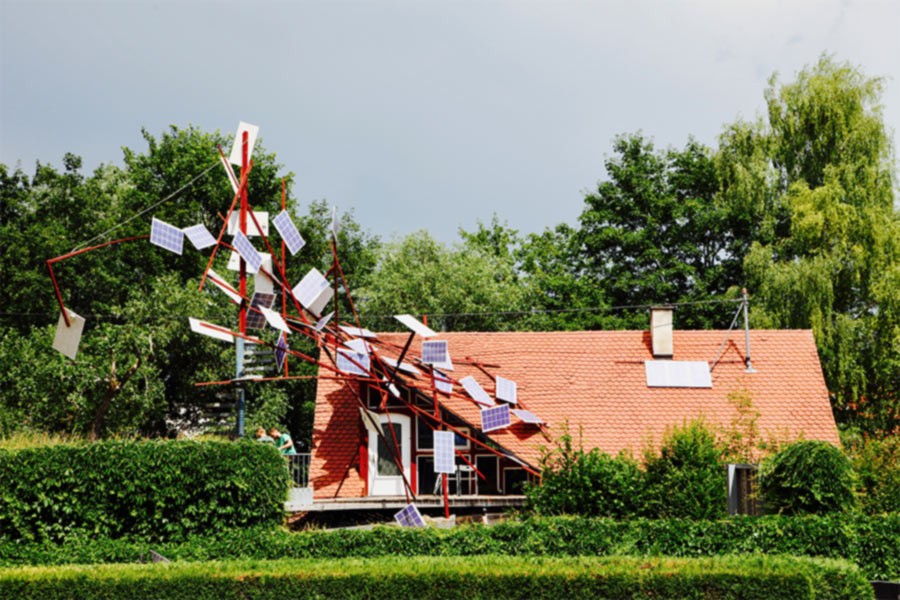
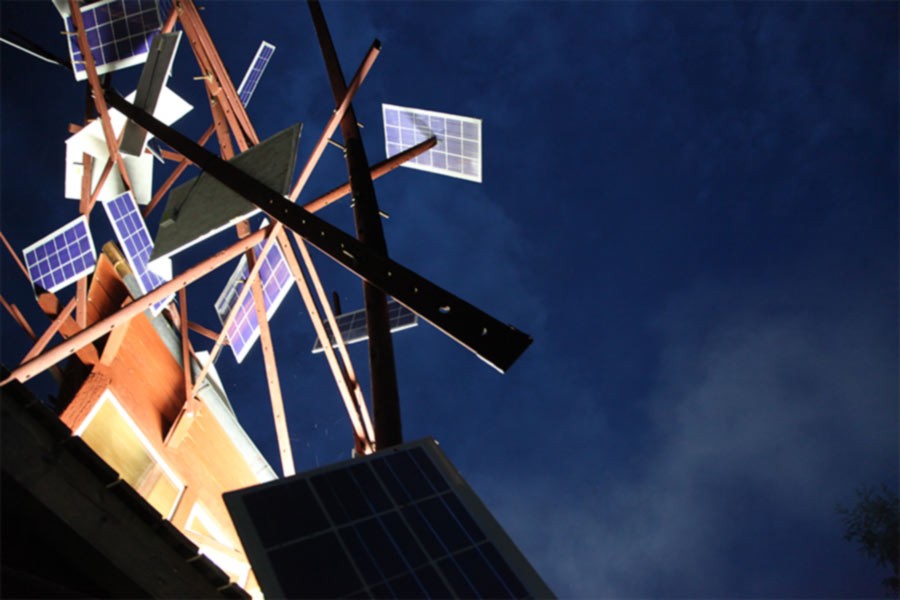
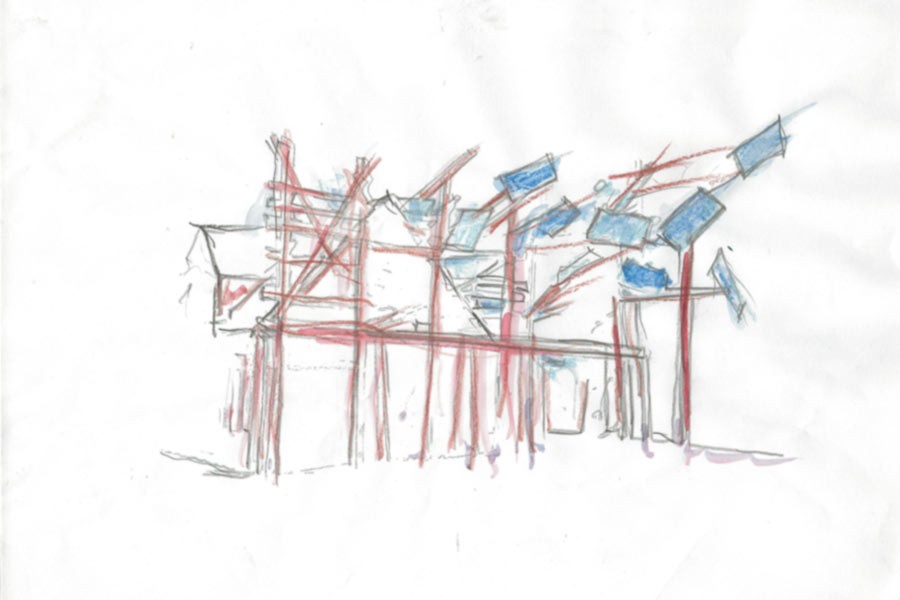
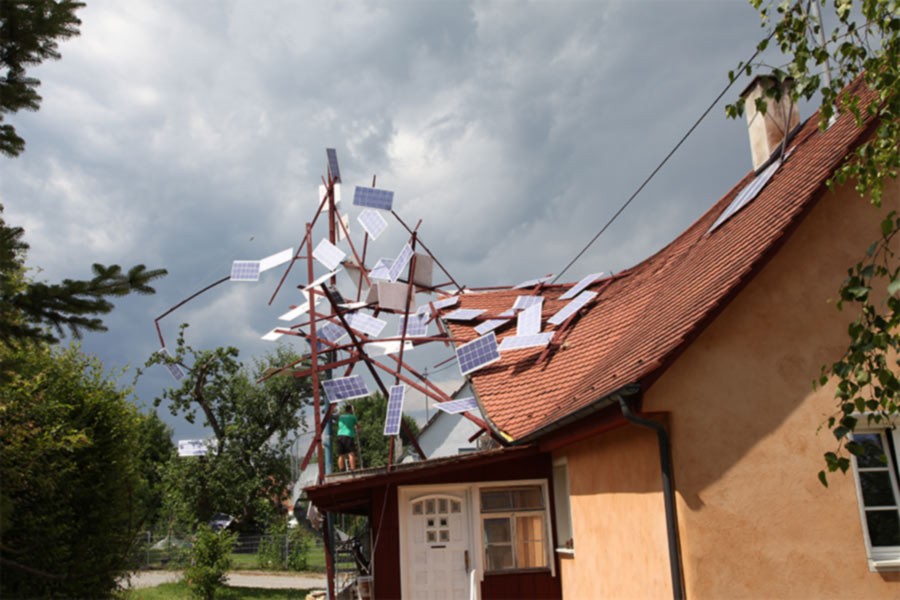
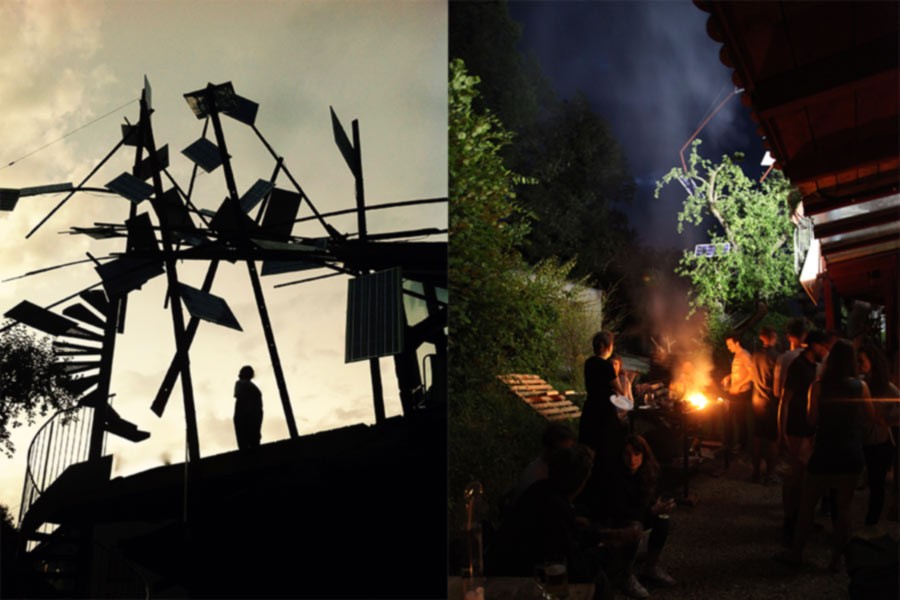
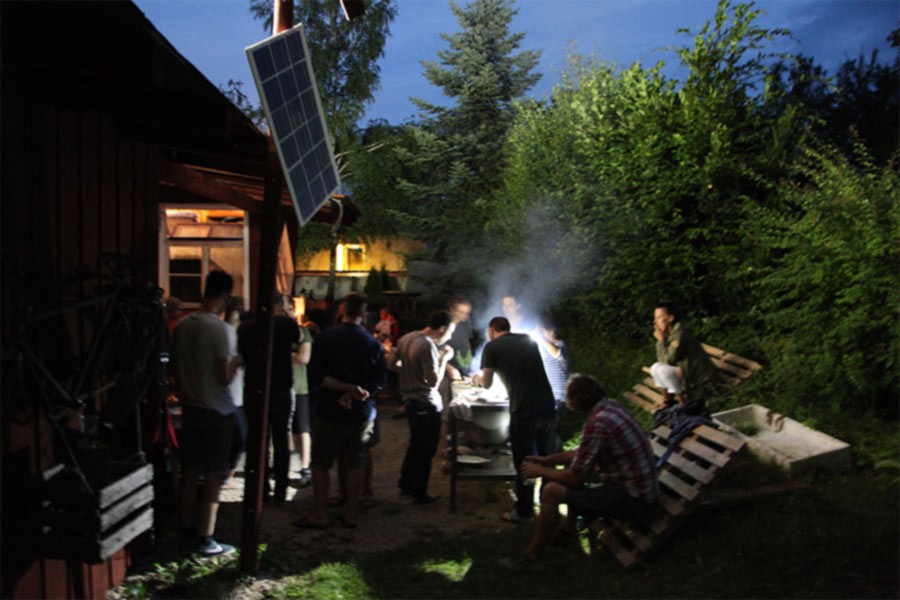
The name of the Kunststrom Kraftwerk Elektisch` Rosa (Swabian Jura) leans on the previous owner of the house who was known among the villagers for her electrifying personality and who was called Elektisch` Rosa. Up to an old age, Elektisch` Rosa maintained an energetic and conscious lifestyle. The Kunststrom Kraftwerk produces Kunststrom that can be sourced from Performance Electrics gGmbH. We would like to thank all partners and helpers.
Motorbonk
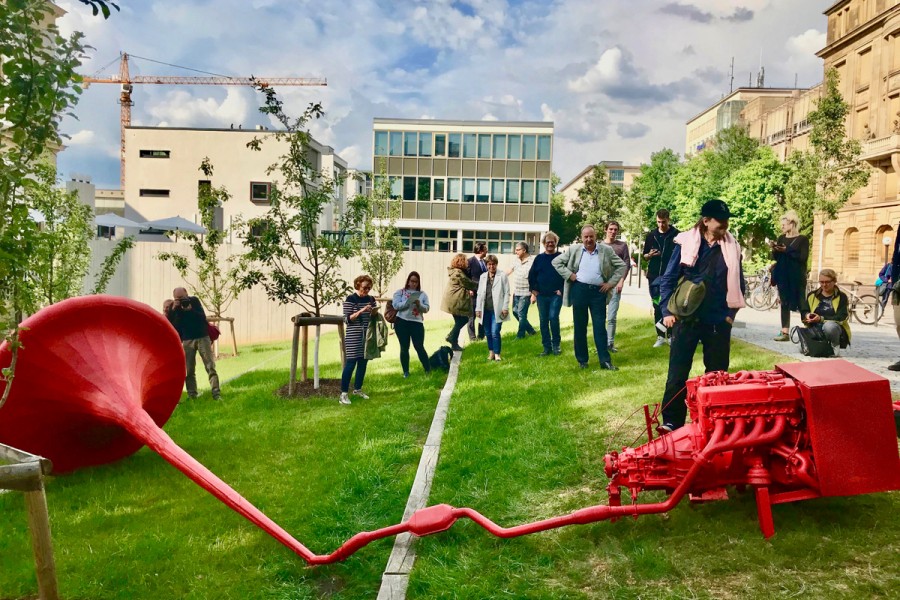
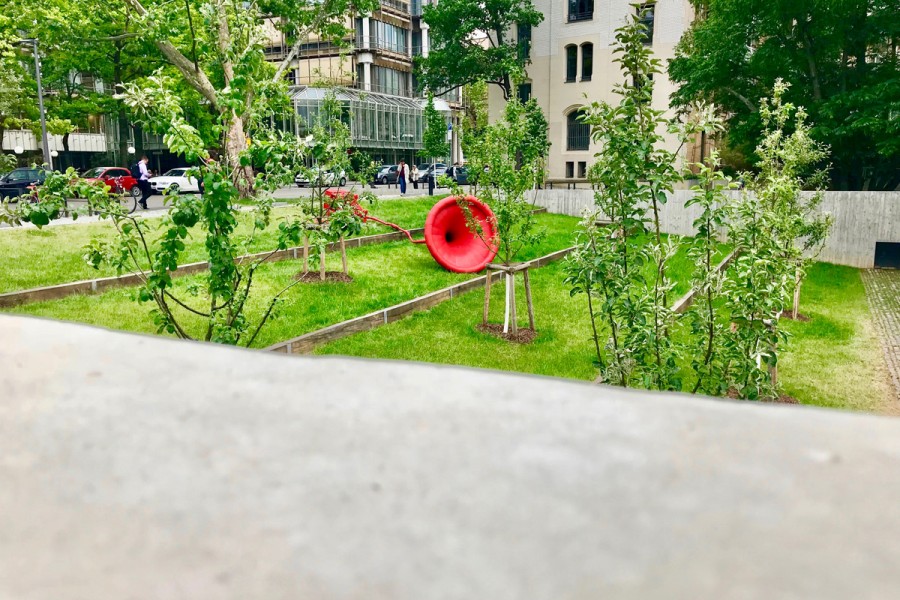
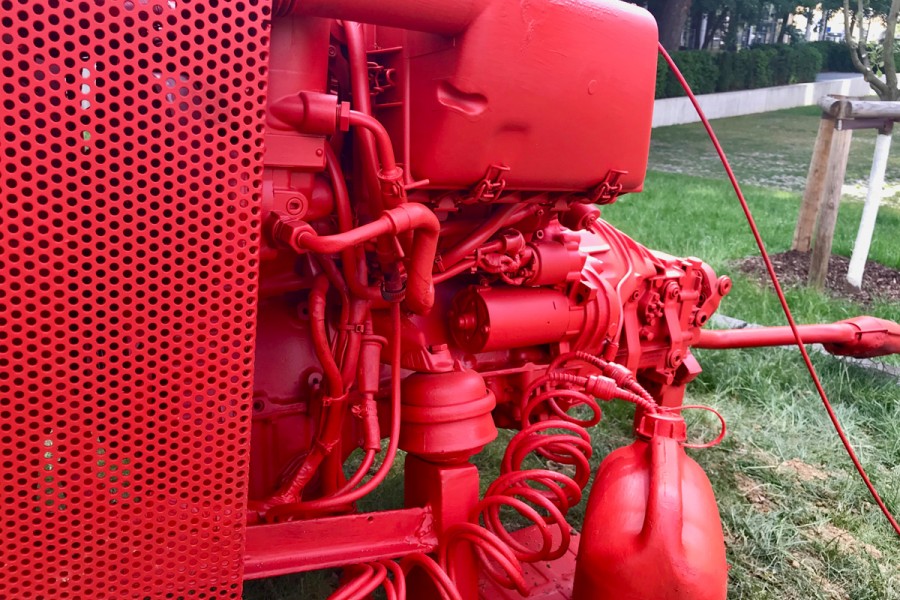
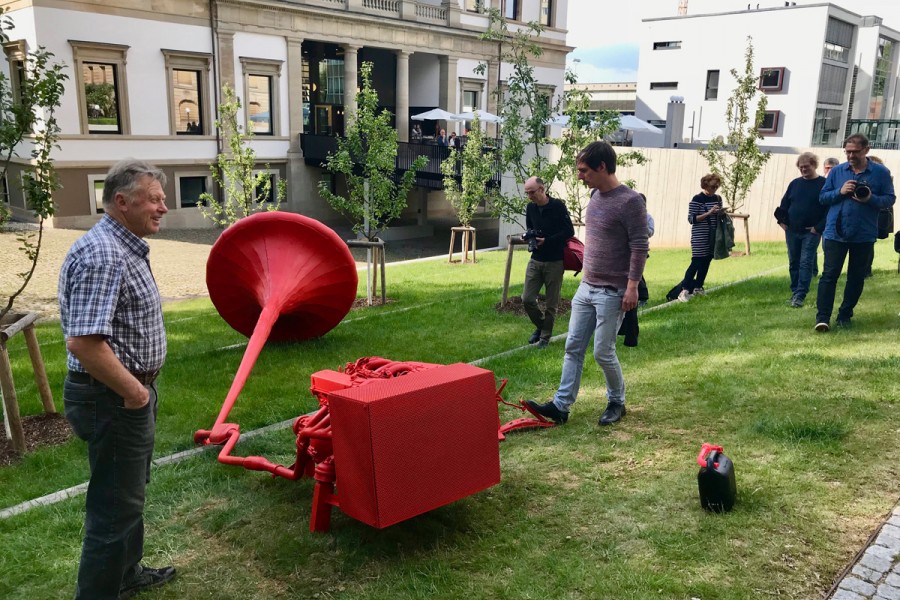
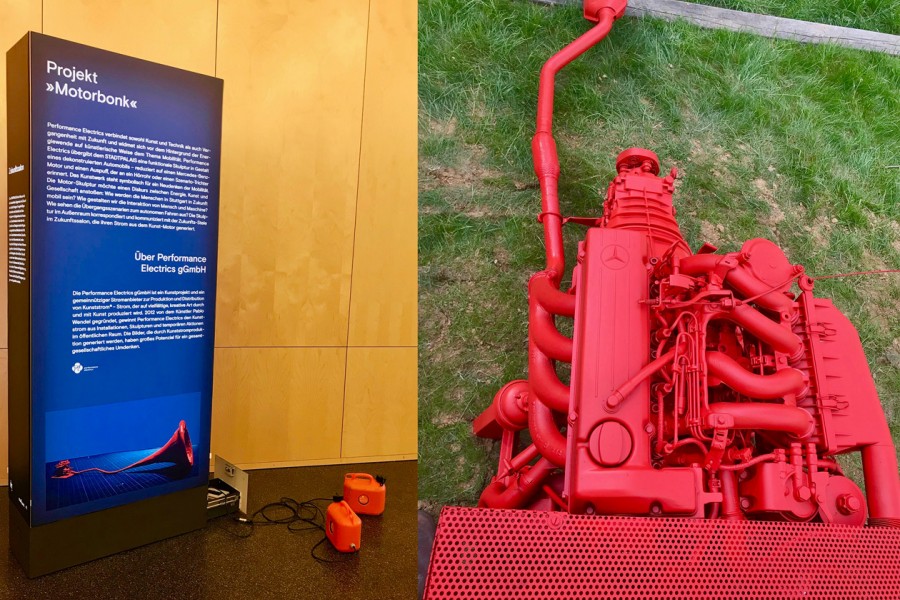
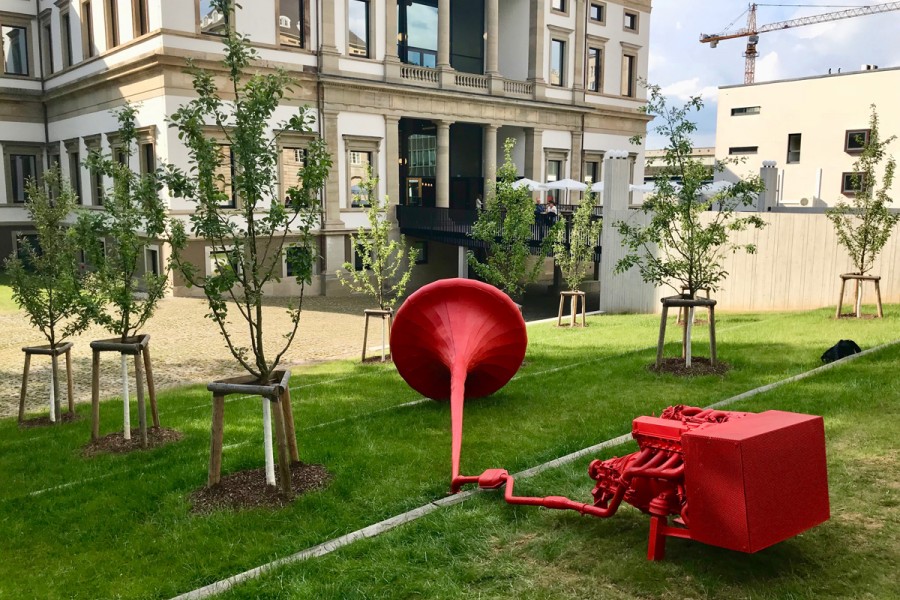
Performance Electrics unites art and technology as well as the past with the future and is, against the background of the energy transition, artistically devoted to the subject of mobility. Motorbonk is a functional sculpture in form of a deconstructed automotive vehicle – reduced to a Mercedes Benz motor and an exhaust pipe that is reminiscent of an ear trumpet or a scenario funnel. The artwork is representative of the new mindset of mobility.
The motor-sculpture wants to launch a discourse between energy, art and society: In future, which mode of transportation are the people in Stuttgart going to choose? How do we shape the interaction between human beings and machines? How could the transitional scenarios to autonomous transport look like? The sculpture generates Kunsttrom for the Stadtpalais – Museum für Stuttgart and supplies a future-stele in the futurelounge of the museum.
Sternenfänger
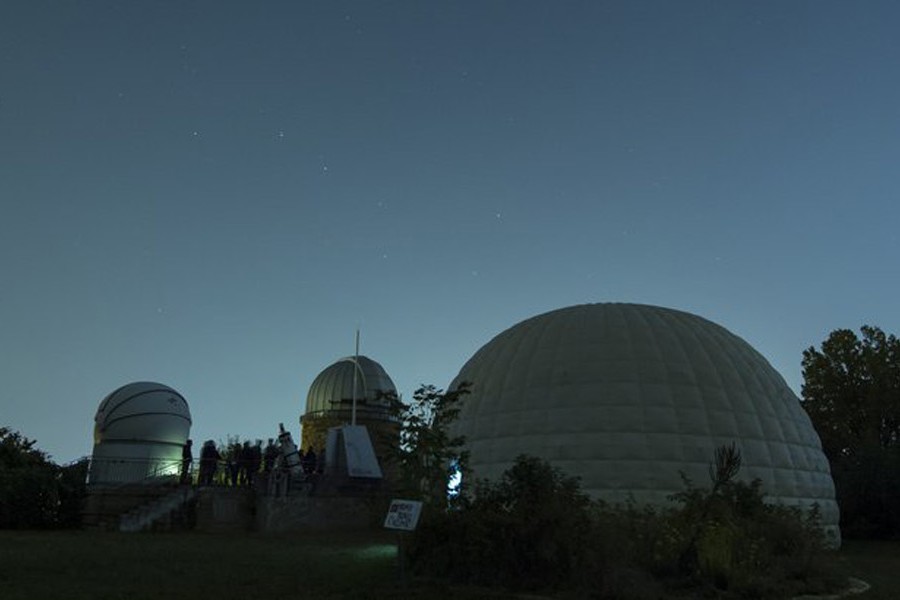
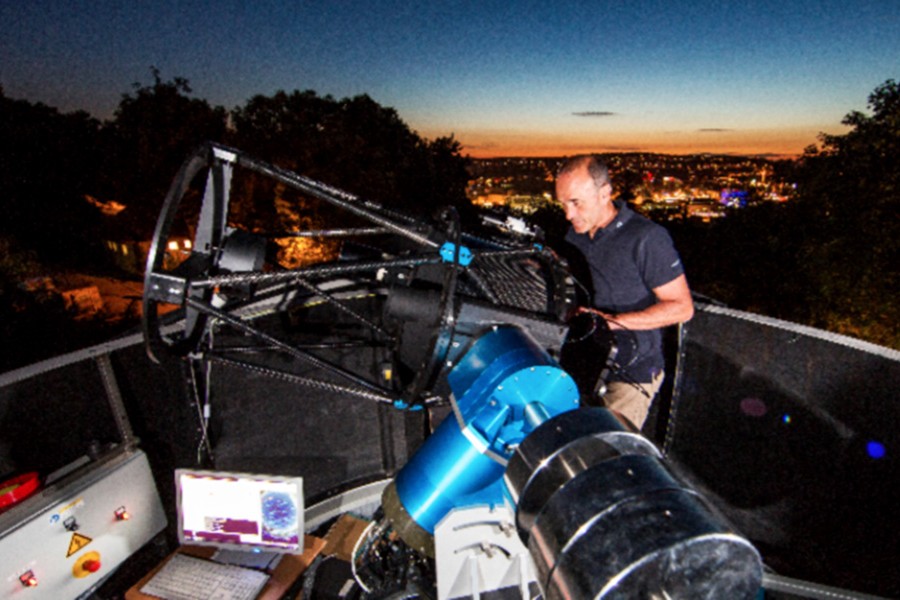

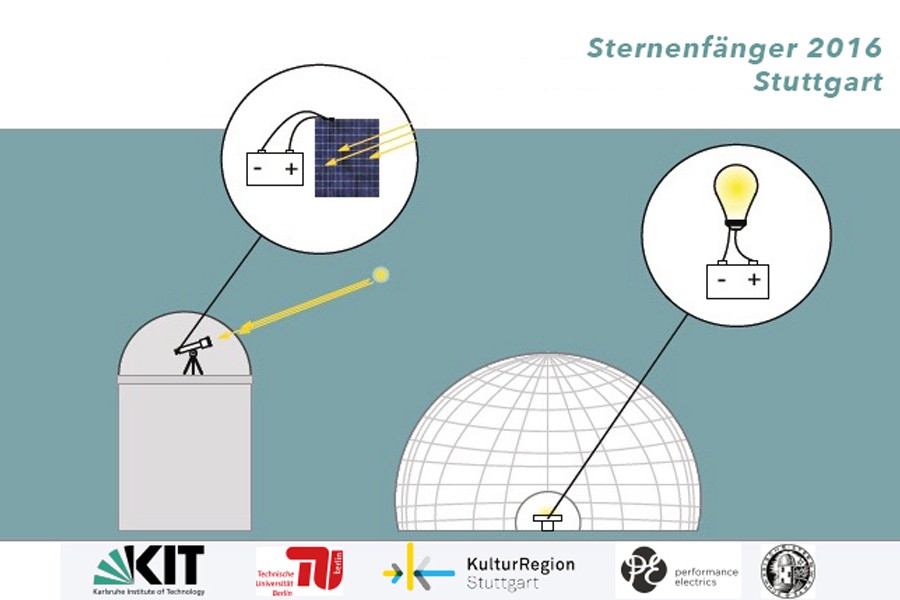
A glimpse at the sky reveals: we are surrounded by light and this means energy. We have benefitted from the energy of our closest star, the sun, as long as we can remember. The sun warms us and enables the growth of organic life. We collect and condense its energy. Why, we asked ourselves, not also capture the light energy of other stars and planets that are further away und thereby resort to the energy potential of the entire cosmos? Performance Electrics gGmbH, founded by Pablo Wendel, which specialises in the production of Kunststrom takes up on this question and realised the project Sternenfänger in the Stuttgart Uhlandshöhe. Together with the Schwäbischen Sternwarte e.V., the Performance Electrics team developed a method to gather light energy from space. By means of a battery, the energy of the starry sky is stored as Kunststrom. In an epitympanic recess behind the observatory in the Uhlandshöhe, the energy of distant planets and maybe even of long extinguished stars lit up a little lamp/ lightbulb.
The semi-circular room is almost engulfed by total darkness, merely the light of the little lamp reveals the barely apprehensible power of the ephemeral light that has been captured out of the infinite widths of the universe.
The light that shines through the cosmic space becomes experienceable in its physical and energetic qualities. In the delicacy of the light pulse, the transformation of star energy acquires a poetic dimension.
Kooperationspartner:
Sternwarte e.V. Stuttgart (Observatory) Andreas Eberle, Karlsruher Institut für Technologie Lichttechnisches Institut Materialwissenschaftliches Zentrum für Energiesysteme MZE. M.Sc. Daniel Bahro, TU Berlin Fachgebiet: Elektrische Energiespeichertechnik Institut für Energie und Automatisierungstechnik Prof. Dr.-Ing. Julia Kowal, KulturRegion Stuttgart Katharina Ess, Julia Connert, Joachim Fleischer (Curator)
Pylonia
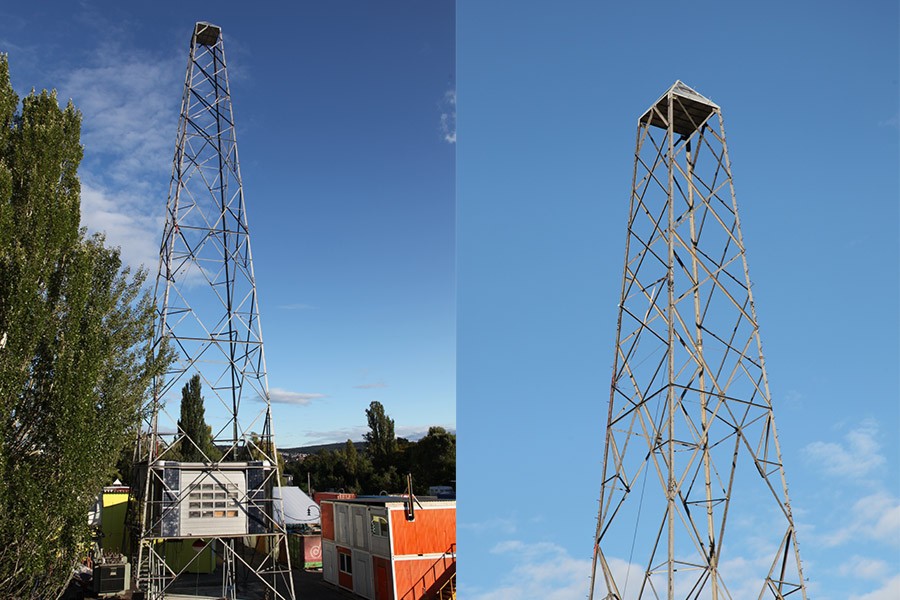
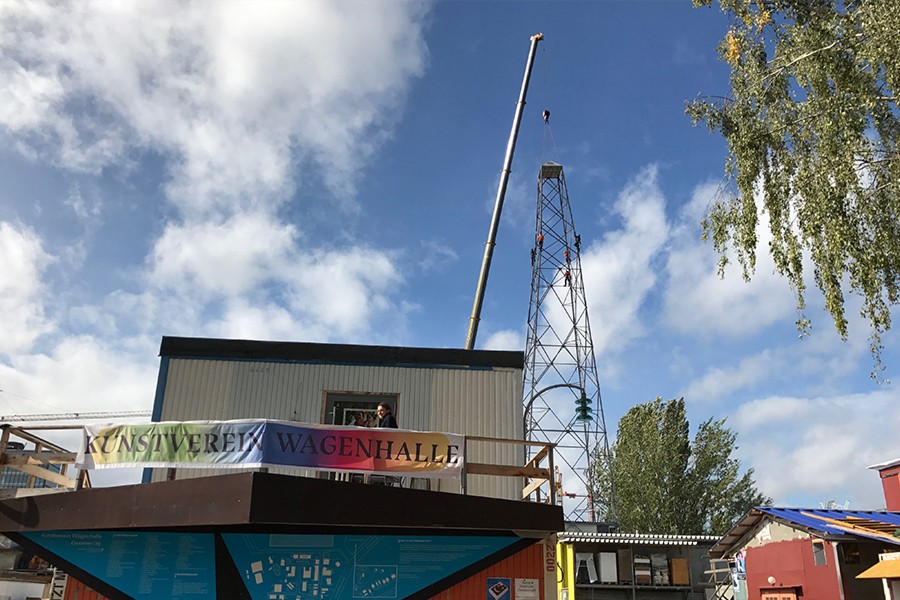
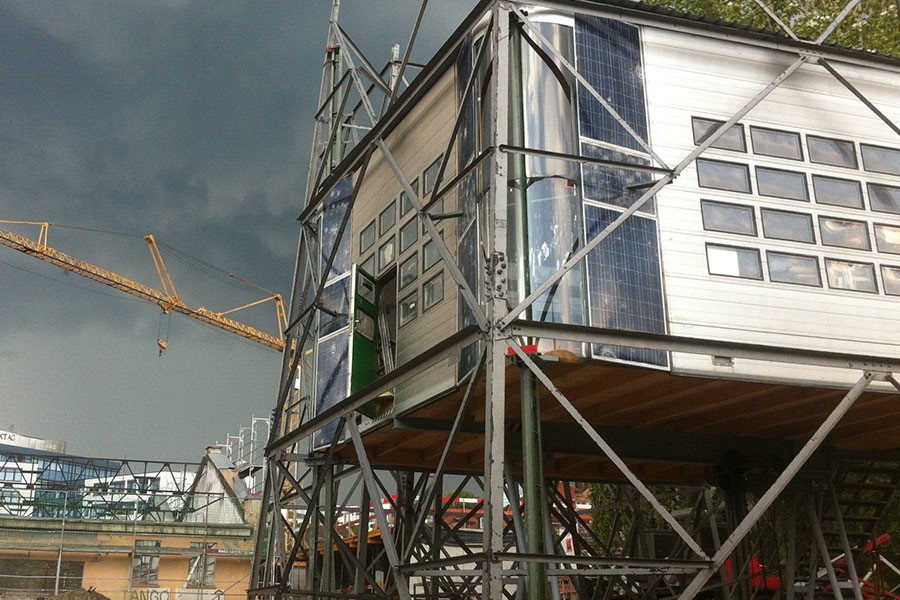
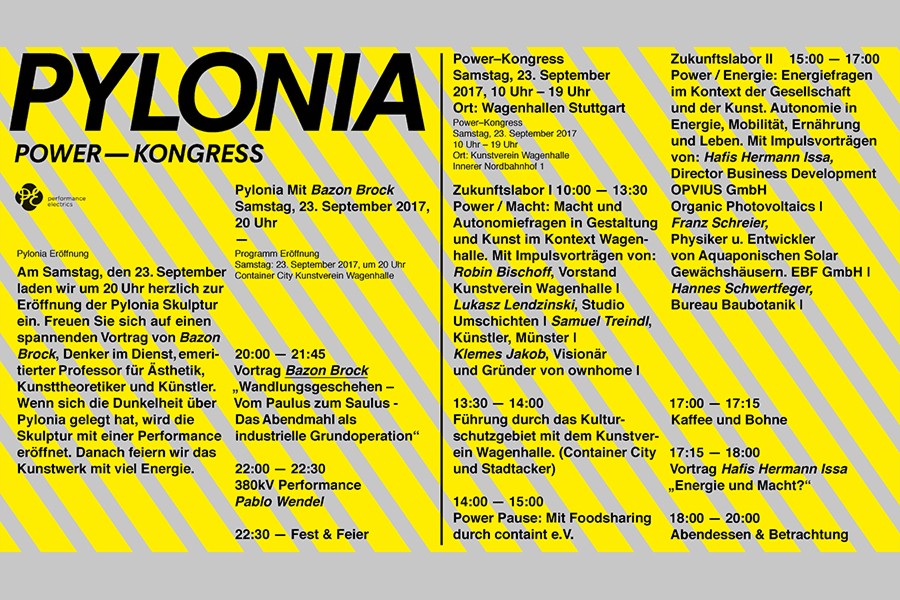
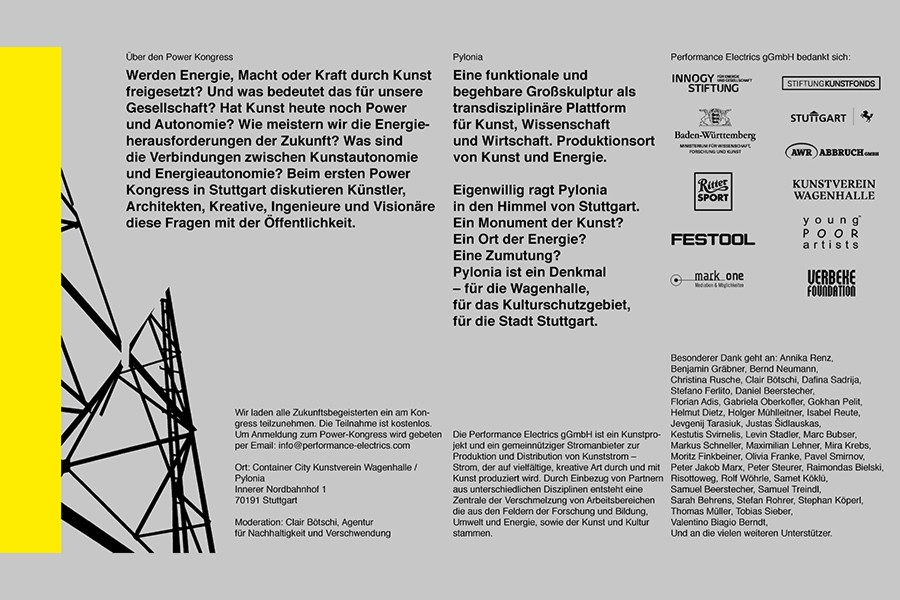
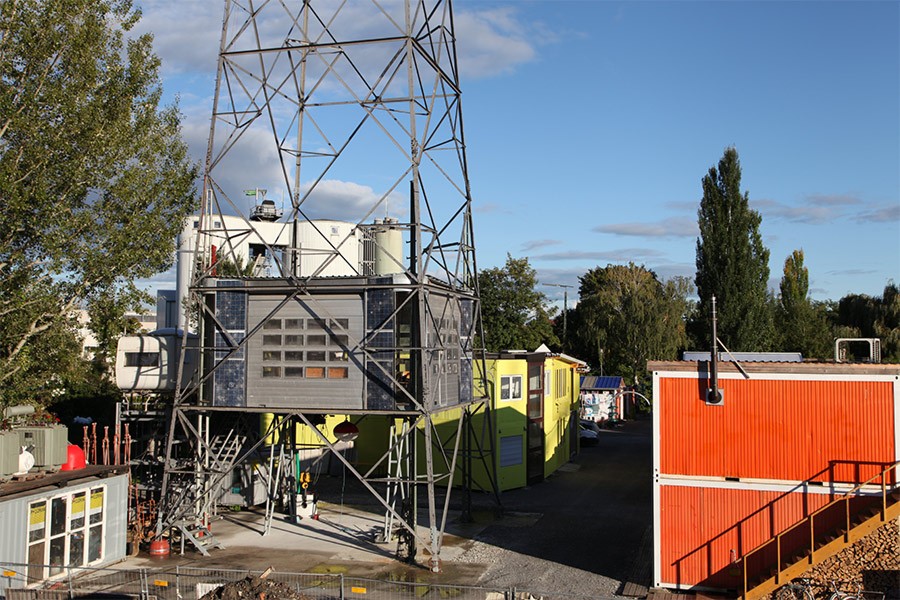
Pylonia
A functional and accessible large-scale sculpture as a transdisciplinary platform for art, science and economy. Production site for art and energy. Pylonia wilfully towers over the sky in Stuttgart. An artistic landmark? A place of energy? An imposition? Pylonia is a monument – for the Wagenhalle, for the cultural sanctuary, for the city of Stuttgart.
A project from performance electrics with kind support from Innogy Stiftung, Stiftung Kunstfonds, Kunstverein Wagenhalle e. V., city of Stuttgart, Ministerium für Wissenschaft Forschung und Kunst Baden Württemberg, Ritter Sport, AWR Abbruch, Festool, young poor artists, mark one – Konzepte und Realisierung, Verbeke Foundation
We would particularly like to thank:
Annika Renz, Benjamin Gräbner, Bernd Neumann, Christina Rusche, Clair Bötschi, Dafina Sadrija, Daniel Beerstecher, Florian Adis, Gabriela Oberkofler, Gokhan Pelit, Helmut Dietz, Holger Mühlleitner, Isabel Reuter, Jevgenij Tarasiuk, Justas Šidlauskas, Kestutis Svirnelis, Levin Stadler, Marc Bubser, Markus Schneller, Maximilian Lehner, Mira Krebs, Moritz Finkbeiner, Olivia Franke, Pavel Smirnov, Peter Jakob Marx, Peter Steurer, Raimondas Bielski, Risottoweg, Rolf Wöhrle, Samet Köklü, Samuel Beerstecher, Samuel Treindl, Sarah Behrens, Stefan Rohrer, Stephan Köperl, Thomas Müller, Tobias Sieber, Valentino Biagio Bernd, Jannick Werner, Jonas Möllers, Aurel von Schroeder, Felix Rösler
Container City
Innerer Nordbahnhof 1
70191 Stuttgart, U-Bahn Eckartshaldenweg
Power Station
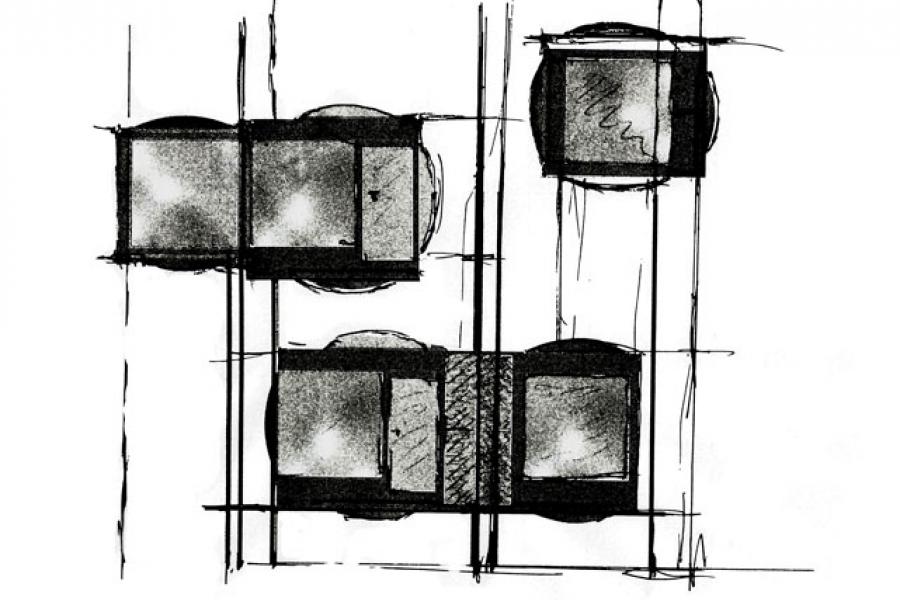
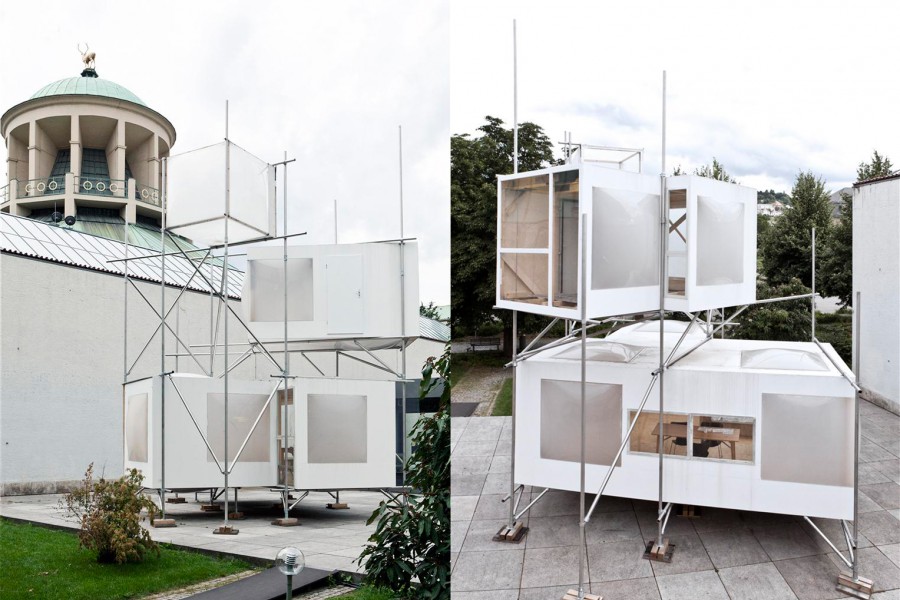
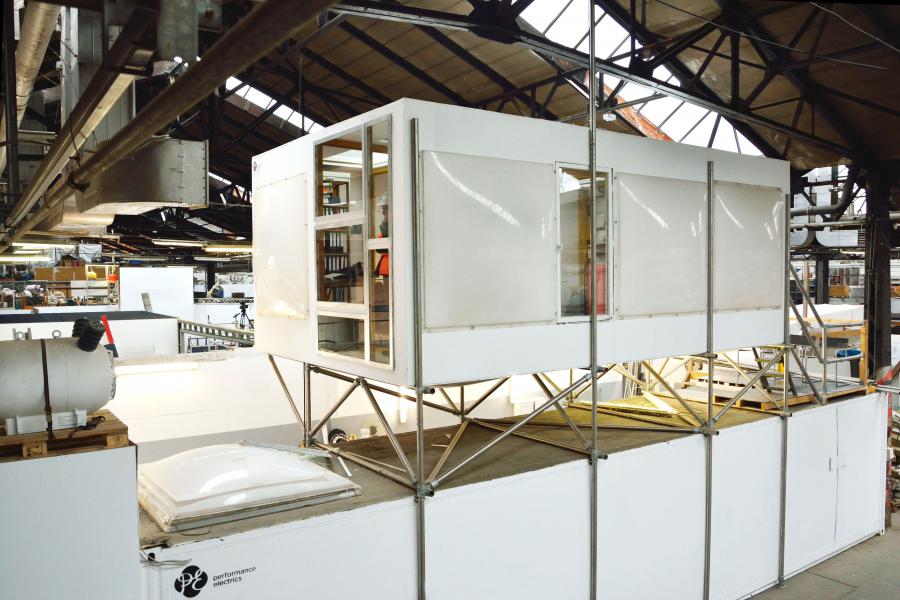
The architectonic Power Station is multi-functional. This structure simultaneously serves as a trans-disciplinary platform for research and development and operates on a technical level to feed Kunststrom into the national grid for commercial distribution. The fact that almost 100% of the PowerStation is built out of recycled material from construction sites, means that the energy output of this building is extremely low. The modularity of the buildings architecture also permits its easy transportation across Europe for new projects and commissions.
PV Guerilla
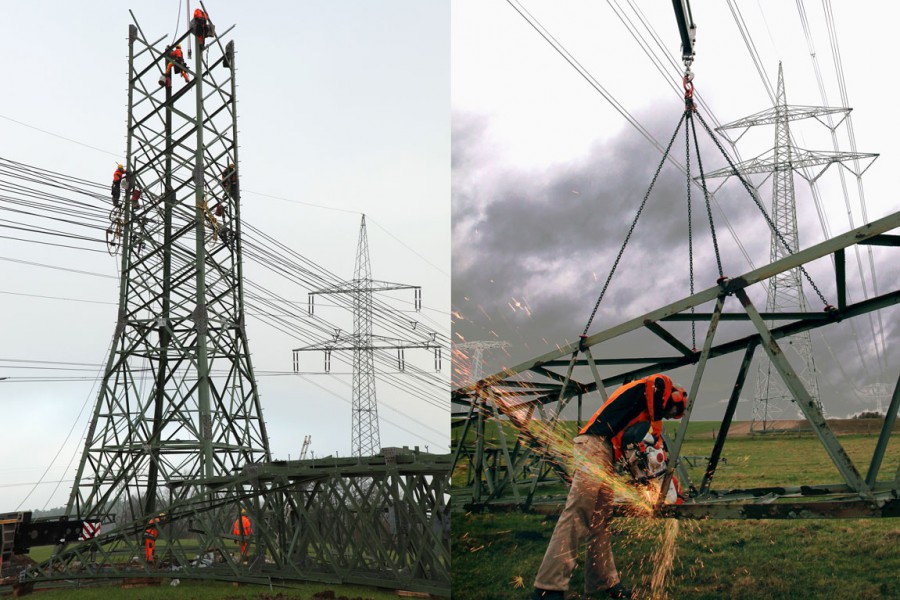
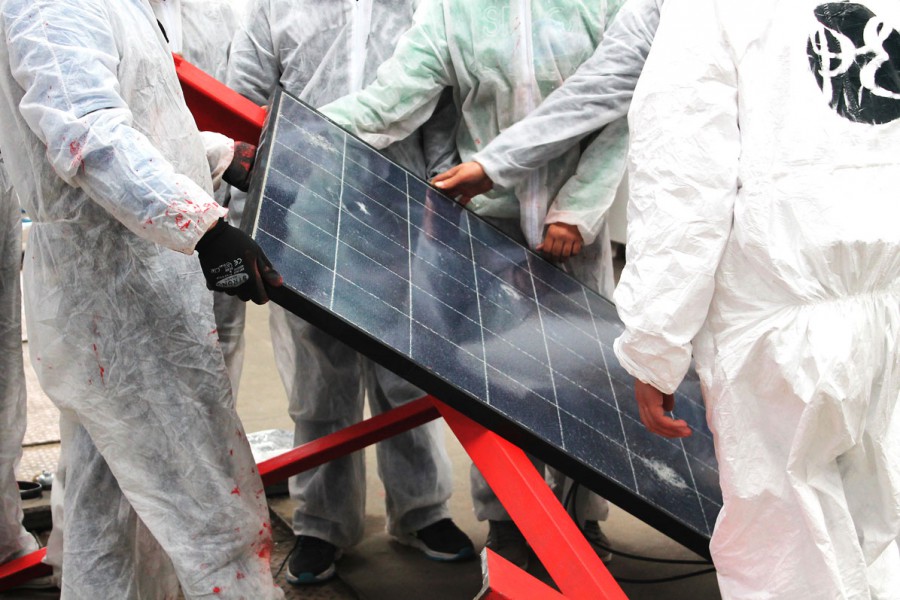
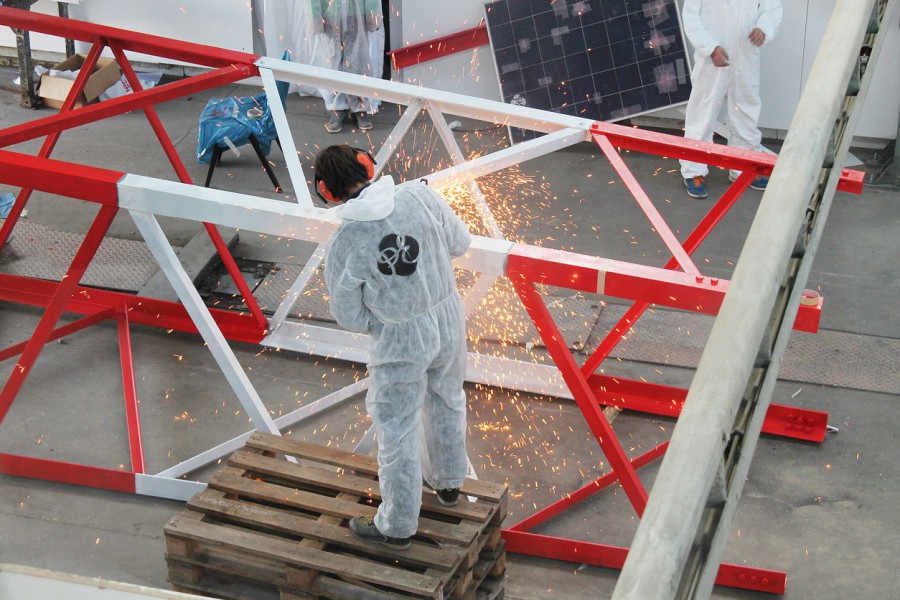
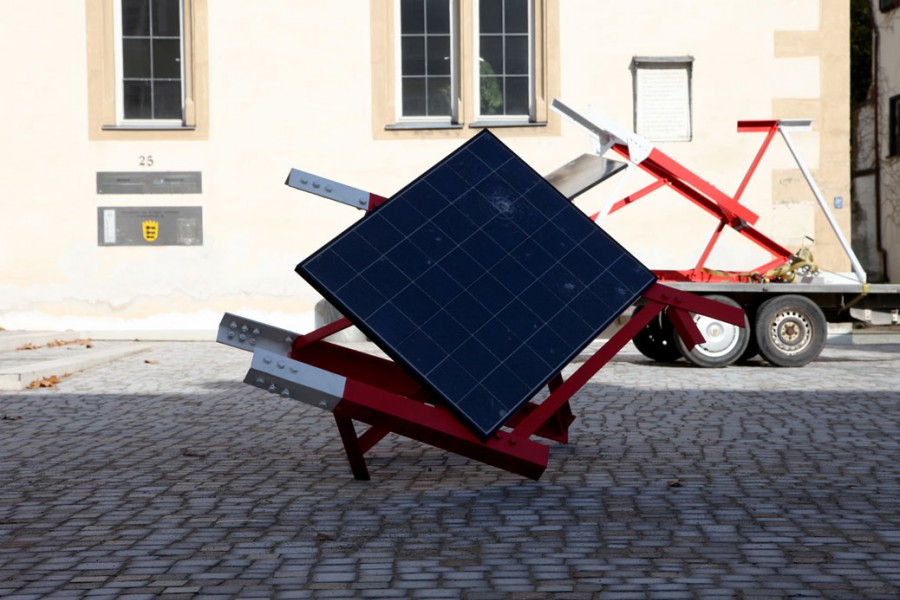
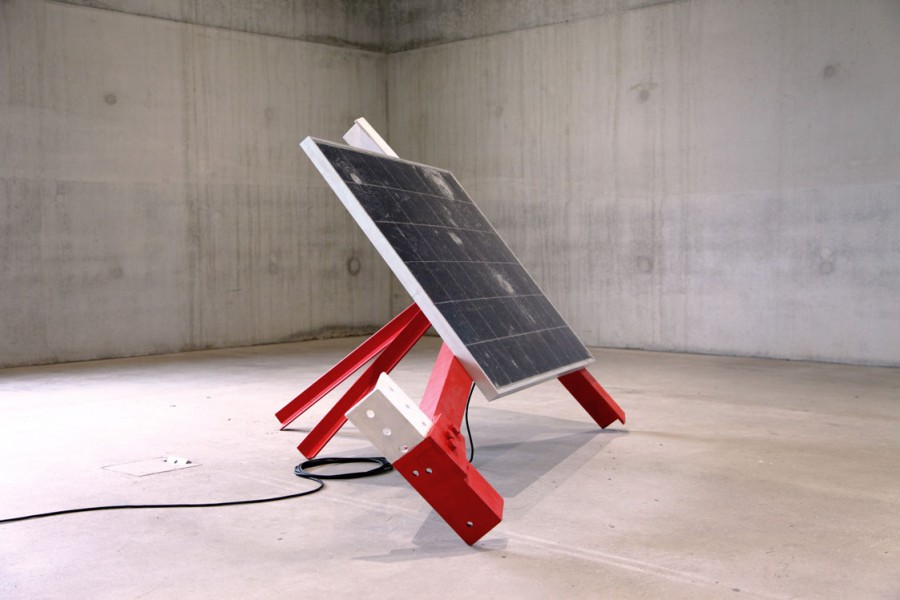
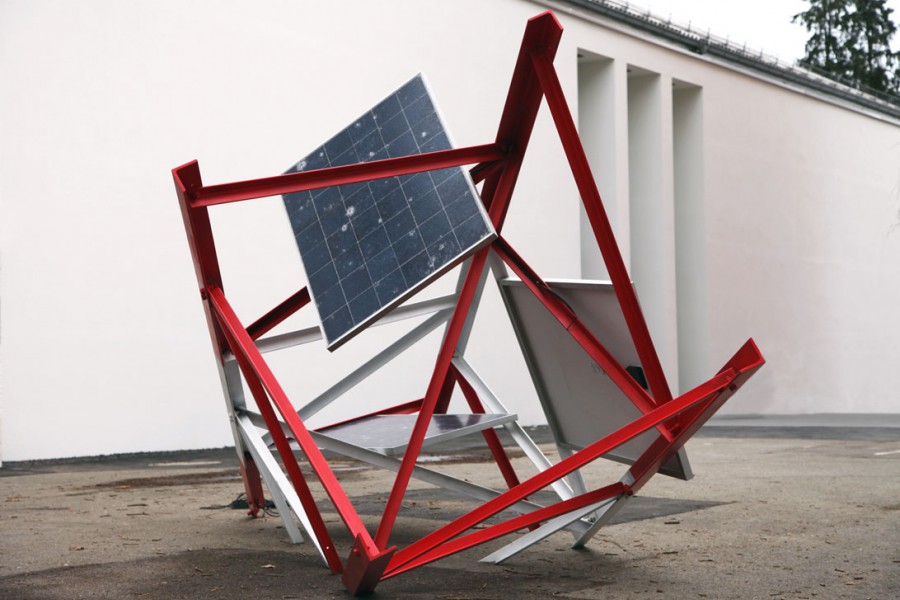
PV guerrilla is an ever-expanding series of sculptures that inherently proposes an alternative solution to centralized, industrial power. Constructed out of electricity pylon fragments, solar panels and a specialist power inverter, these sculptures are able to feed Kunststrom directly from the power socket into the electricity network of any house.
In order to claim this individual power, and circumvent dominant centralized power, individual households, businesses and institutions are invited to lease a sculpture on a monthly basis and thereby create their own Kunststrom. In order to generate maximum levels of Kunststrom private clients are advised to place their sculpture on a household balcony, conservatory or garden and public clients in a public park, roundabout or square of any city.
OFFROAD
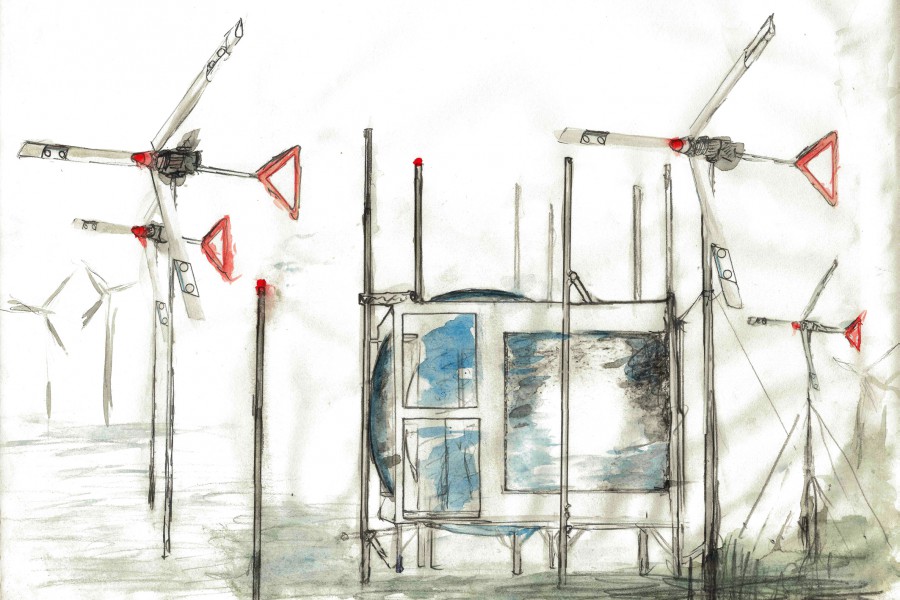
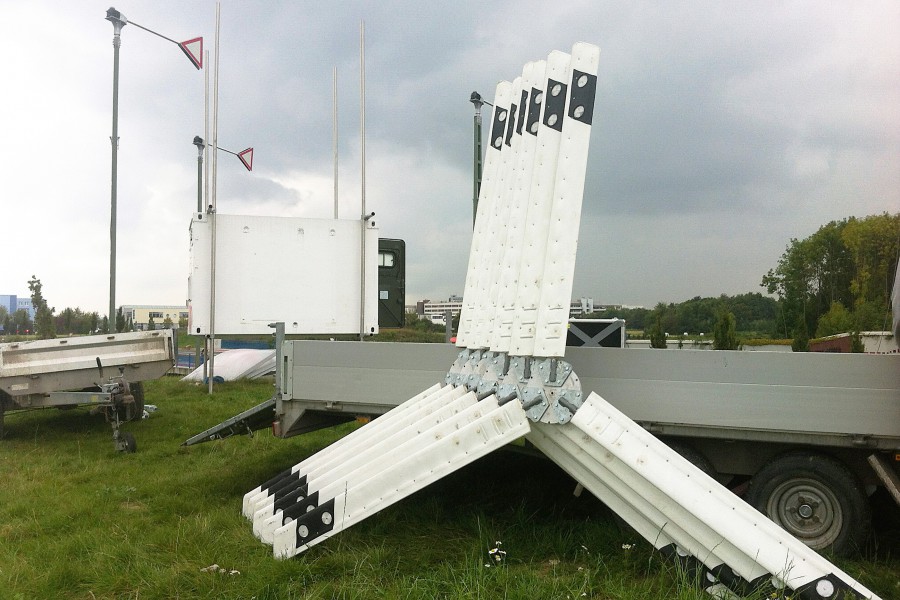
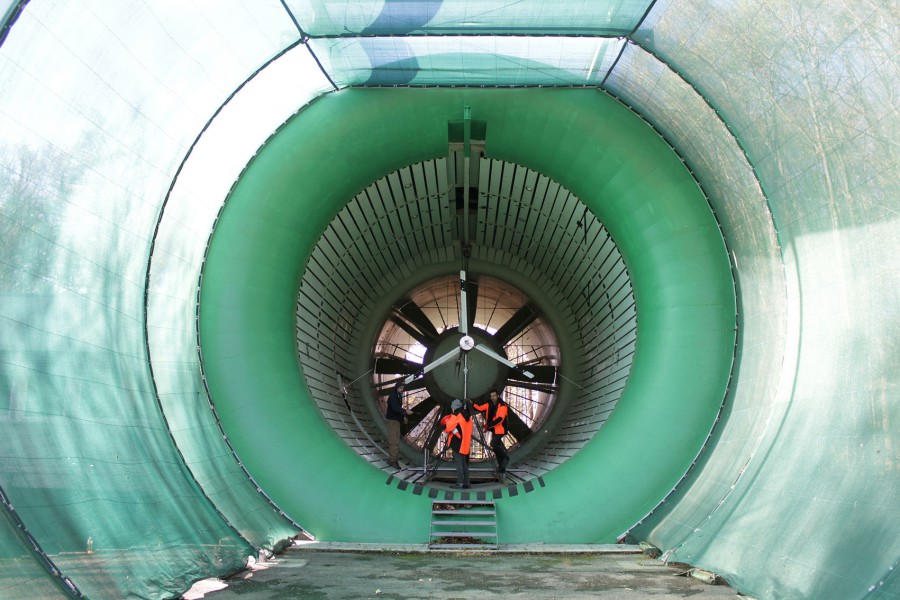
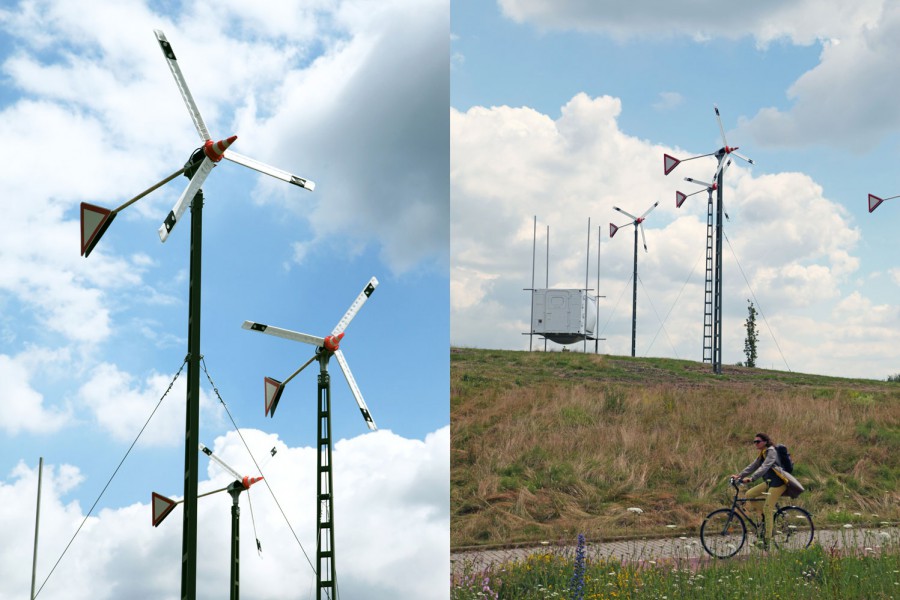
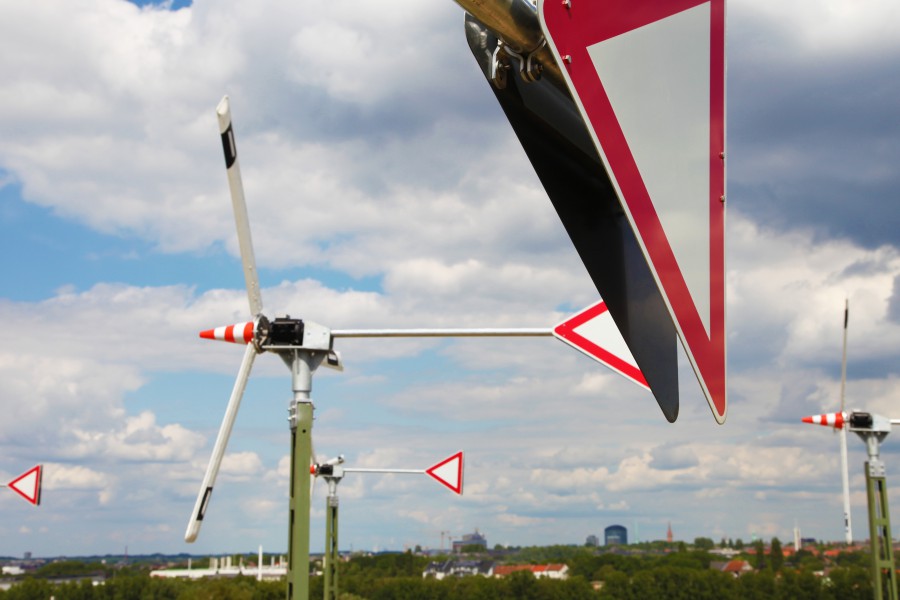
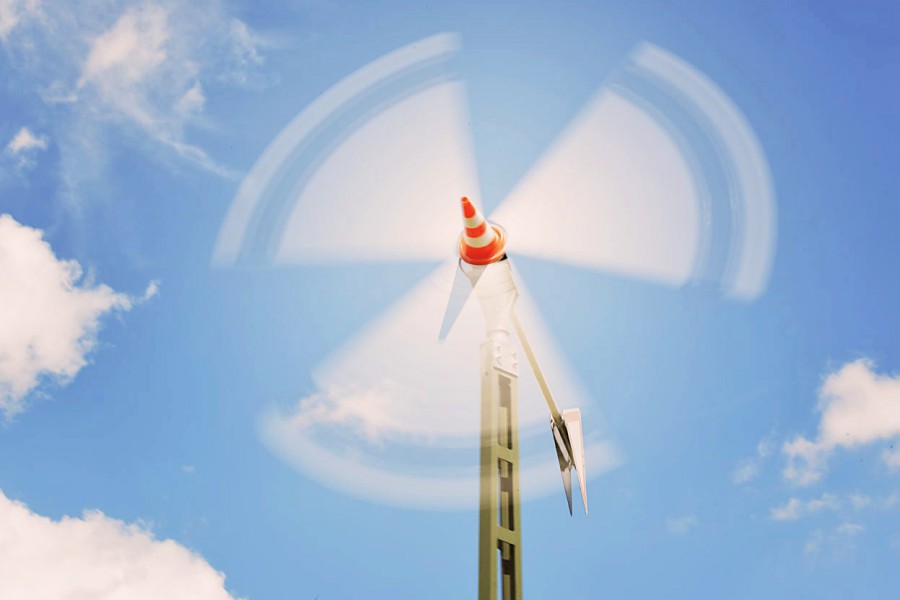
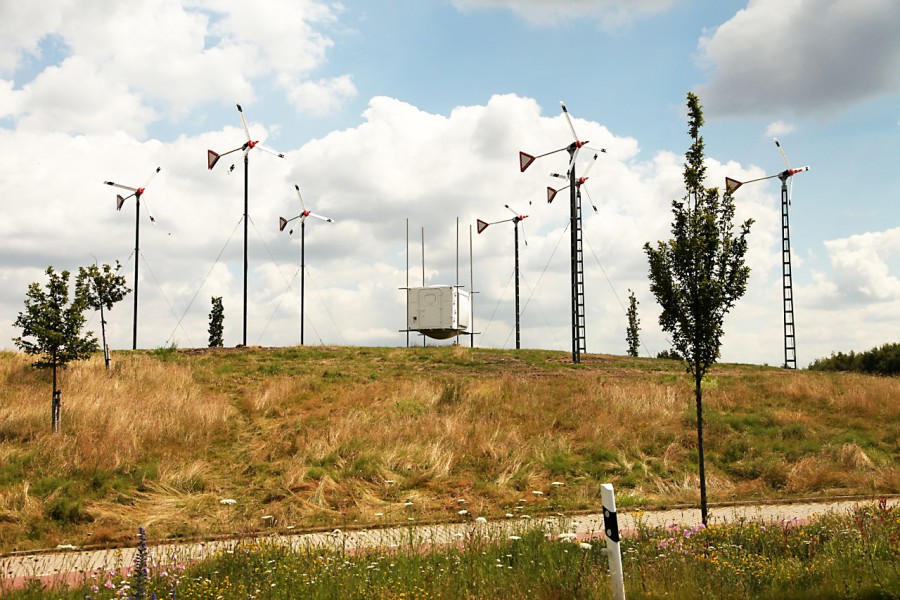
The installation Off Road consists of seven wind sculptures that are each eight metres high, and one Power Station. The sculptures are constructed out of recycled reflector posts and traffic signs from motorways. Off Road transforms the energy potential of roads into new energy and therefore questions how is it possible to manipulate and thereby use the energy provided by our roads?
To cope with the sophisticated engineering demands of this project a trans-disciplinary team was put together in order to research and develop Off Road. Engineering support was funded by the Kulturstiftung des Bundes, scientific support by the Institute of Aerodynamics and Gas Dynamics (University of Stuttgart) and the realisation of the installation funded by the RWE Stiftung. Off Road was presented for the first time with the project B1/A40 – Die Schönheit der großen Straße.
Varta Bande
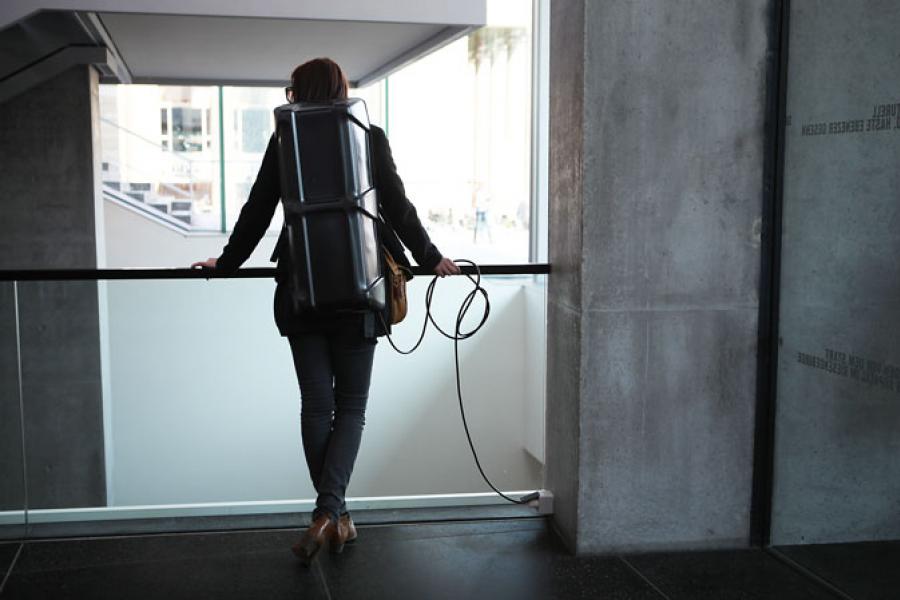
In these guerrilla-style interventions Varta Bande methodically obtain Kunststrom from various public places in city centres, such as Berlin, Stuttgart and Saarbrücken. The Varta Bande consists of a group of performers who tap into different electricity sources in shops or museums in order to charge their sculptural accumulator backpacks. The cocktail of different electricity collected by the performers becomes Kunststrom through the act of the performance and the consequential process of feeding it into the national grid as Kunststrom via the Power Station. The technique used in the accumulators is an advancement of the Super Akku which was developed in 2011 at the Insitute for General Theory.
twenty-four/seven
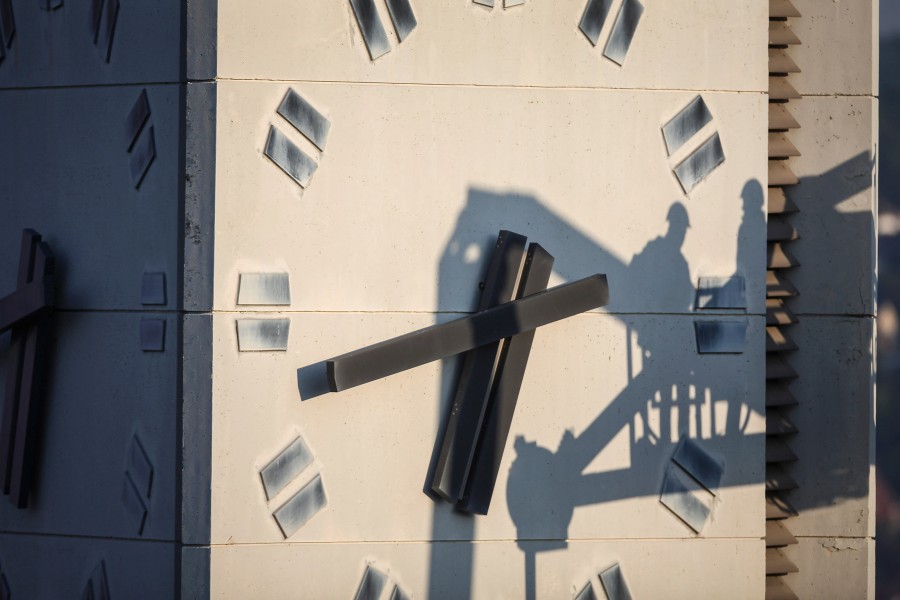
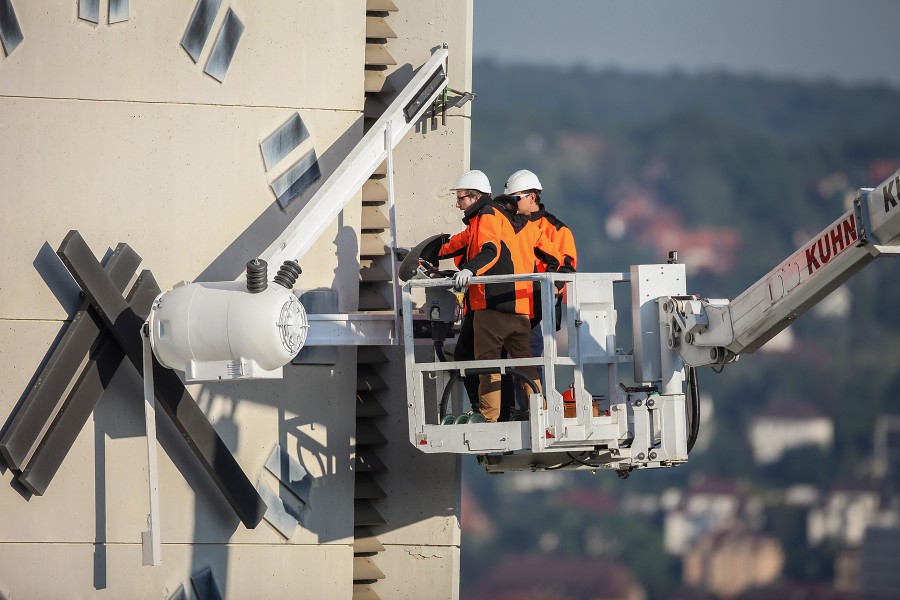
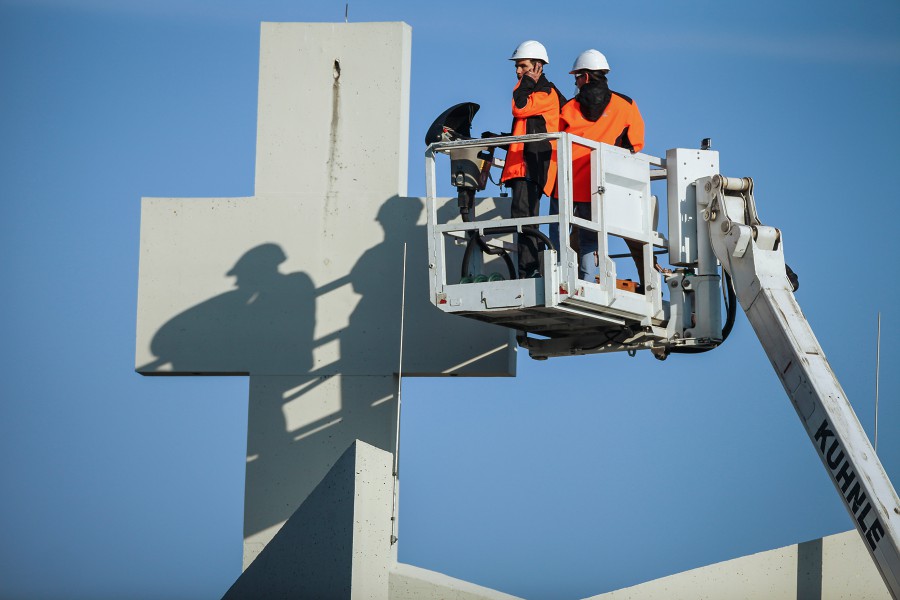
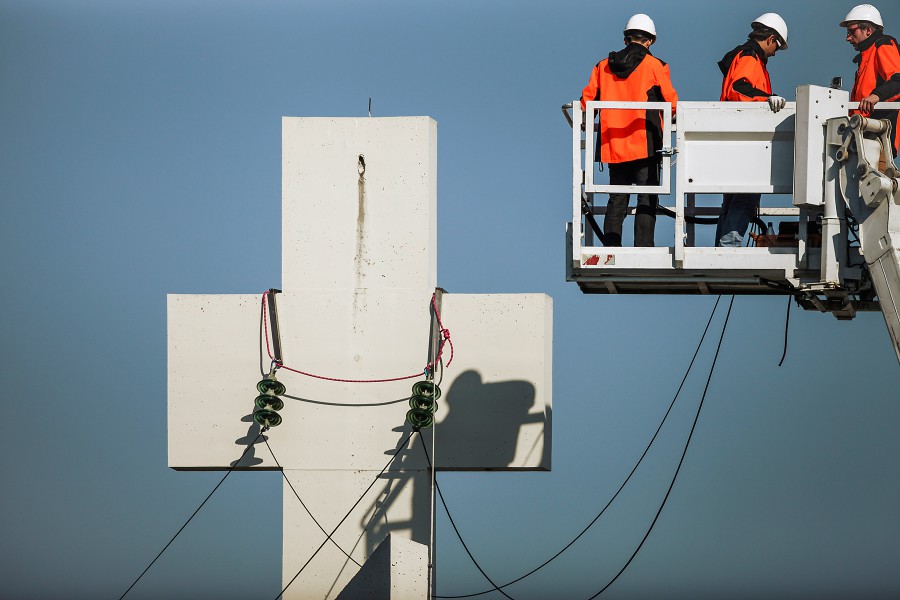
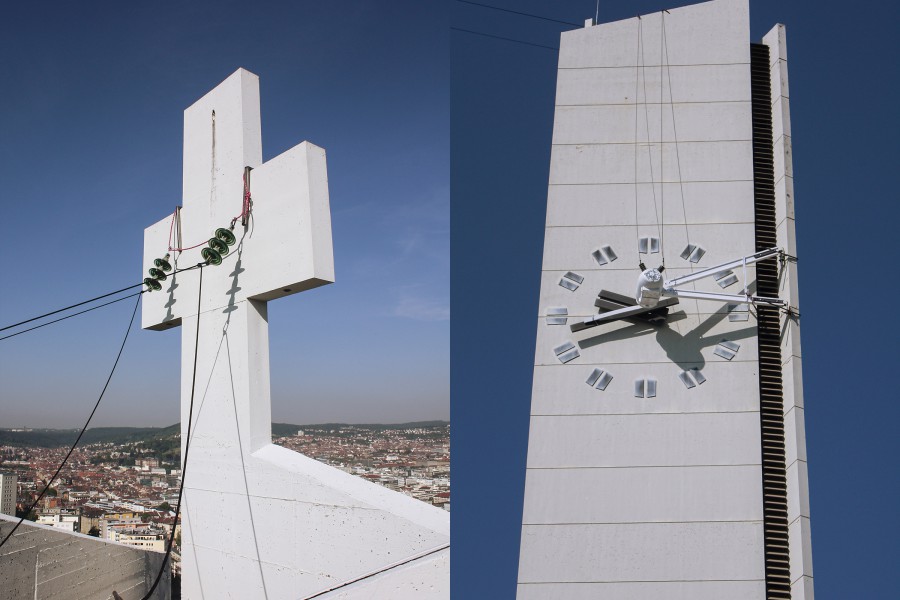
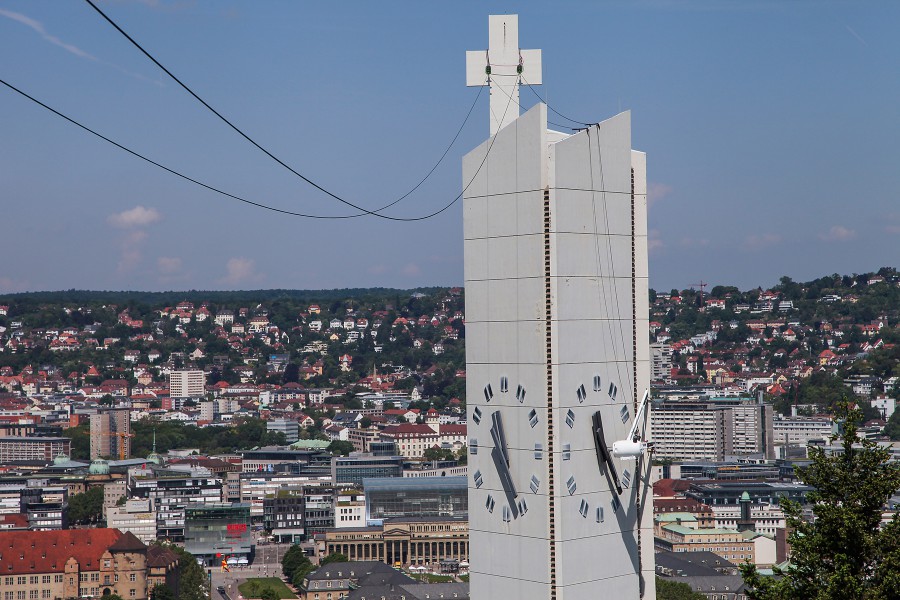
The sculptural intervention twenty-four/seven was conducted without permission on the catholic parish of St. Konrad in Stuttgart in June 2013. This project was developed out of the research on Kunststrom, which focuses on new, creative methods of obtaining Kunststrom in public space. The target was to collect Kunststrom via the kinetic energy of a clock hand. The custom made Kunststrom-generator was mounted onto the 45 meter high clock tower with the aid of a crane. From the church’s highest point Kunststrom was transferred to the nearby Performance Electrics headquarter and thereafter fed into the national grid. Twenty-four/seven poses questions concerning the origin of electricity by creatively sourcing sensational new ways to industrialise unused energy. It highlights the overlooked potential of established infrastructures for the benefit of energy accumulation. As implicated in the title twenty-four/seven the clocks hands provide energy around the clock, which could in theory be utilised for electricity production twenty-four/seven.
Testudo Solaris
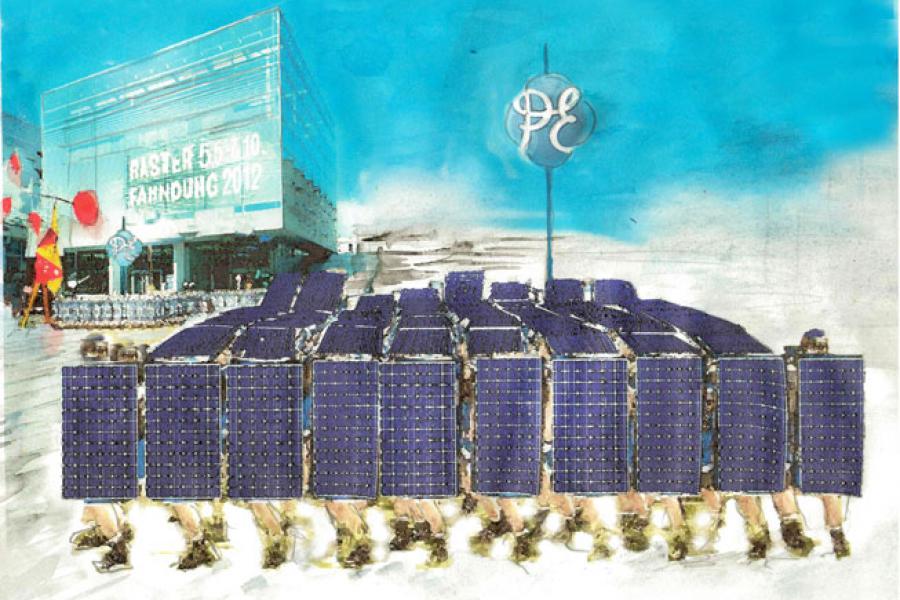
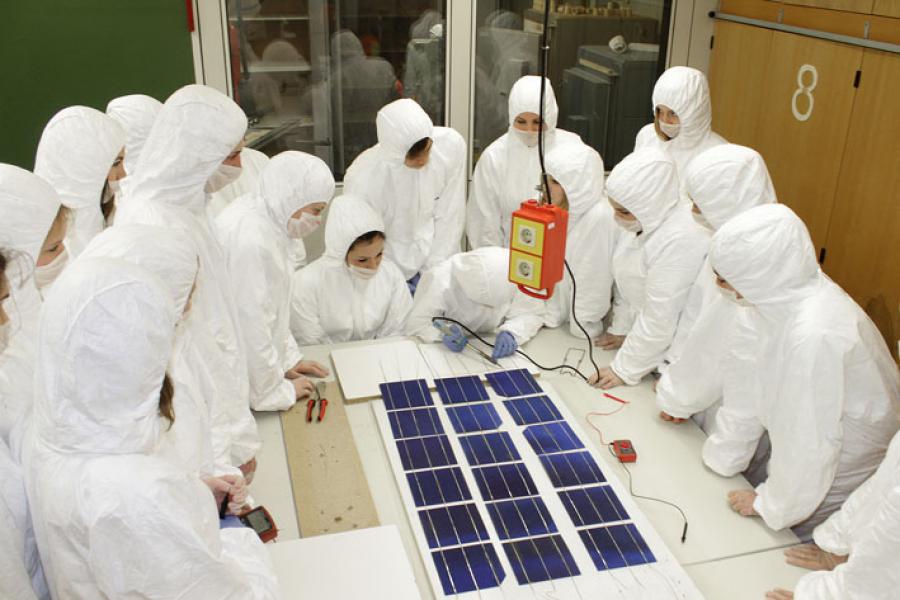
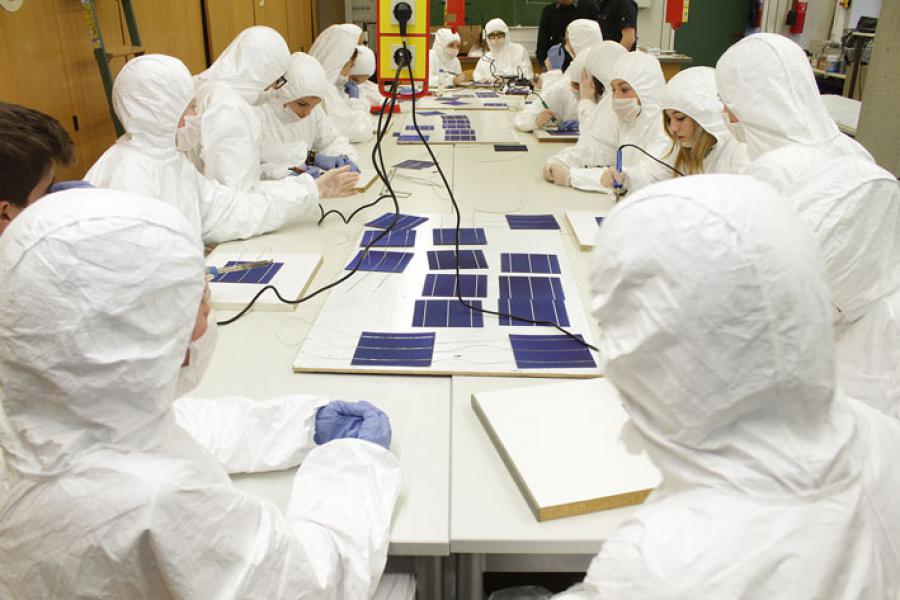
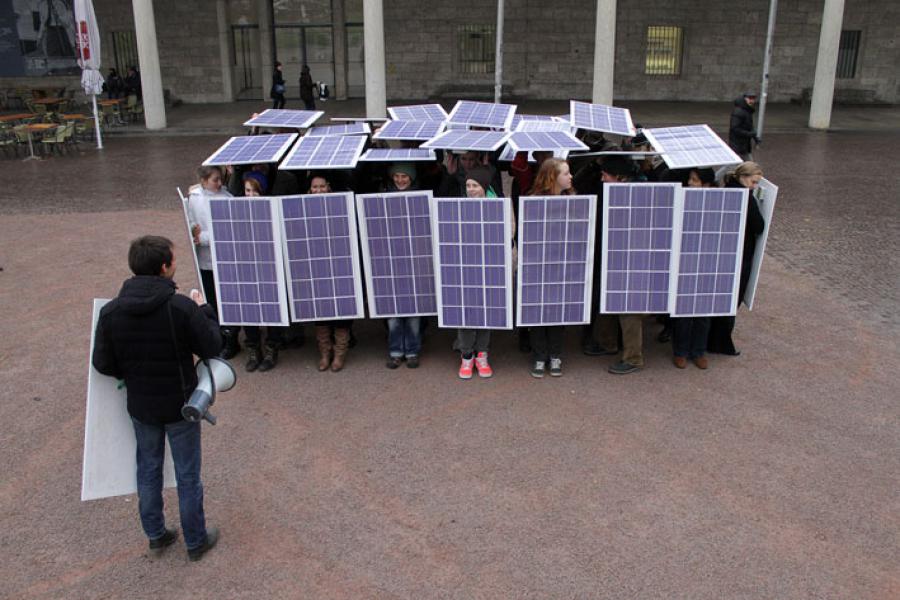
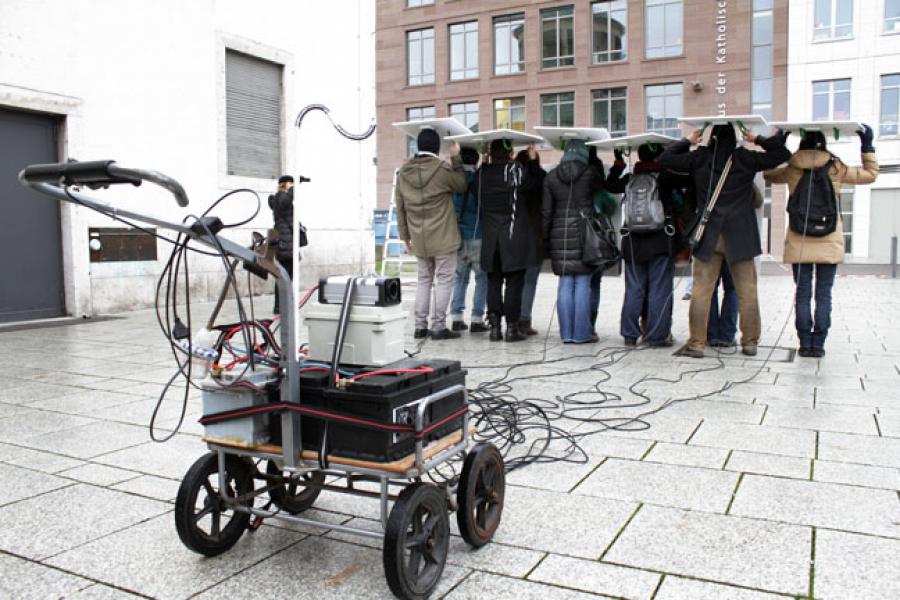
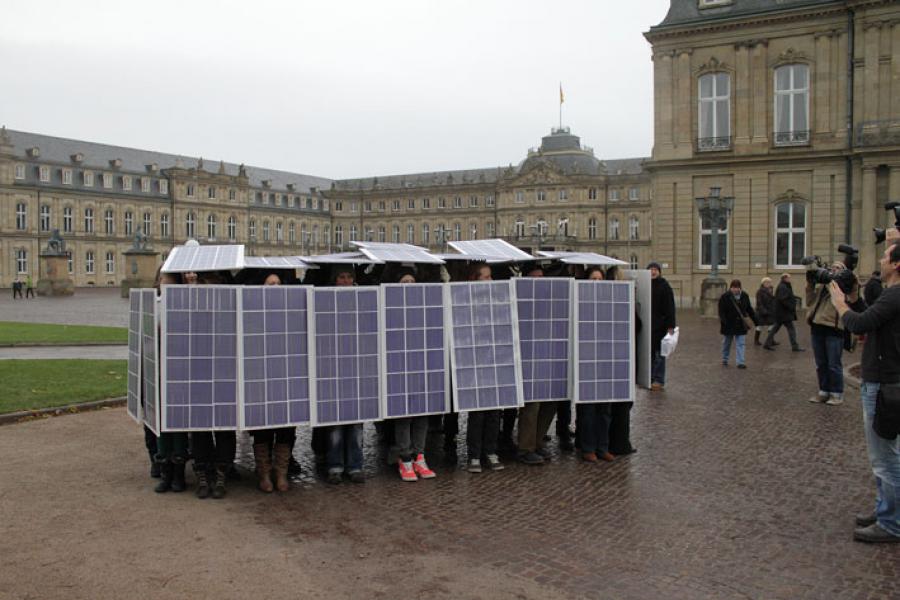
One way of obtaining Kunststrom is through performative and process-based activities, such as Performance Electrics’ temporary, guerrilla-like campaigns. These disruptive interventions in public space are part of Performance Electrics’ subversive strategy. Testudo Solaris is a movement constituted of “Kunststromactivists” whose numbers are growing exponentially. The first union of Kunststrom-activists was in December 2013 in Stuttgart in collaboration with students of several different schools in Stuttgart. In these actions a group of performers move through the city centre with shields made of solar panels in a formation reminiscent of the Roman battle formation “turtle (testudo)”. The handmade solar panel shields were designed using a specifically developed screen-printing method and are available as a limited edition.
Land Sailor Project
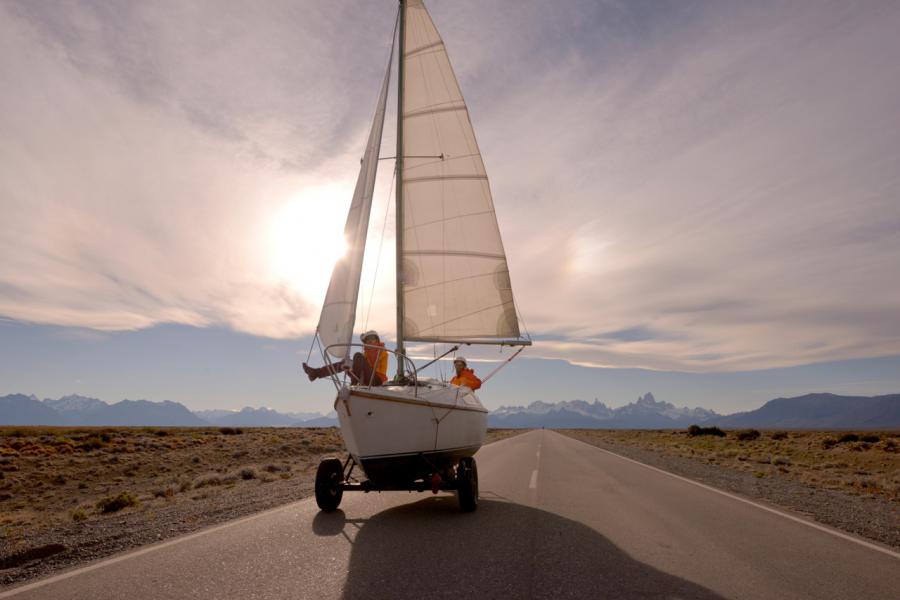

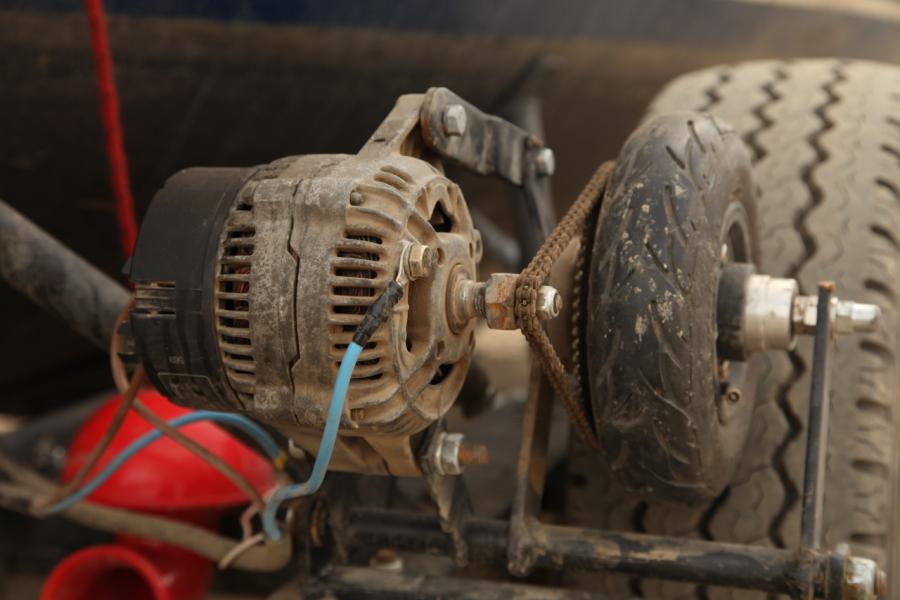
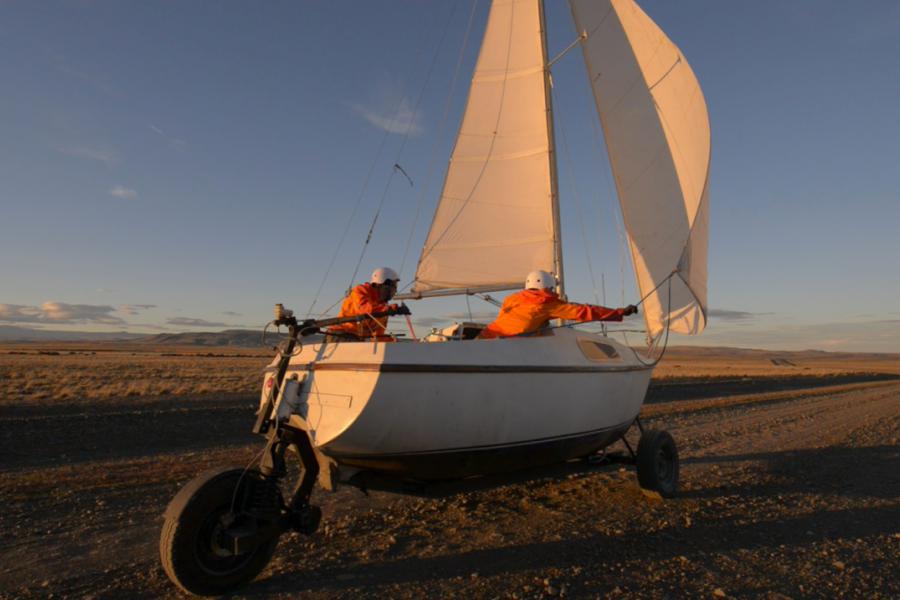
Schmarotzer
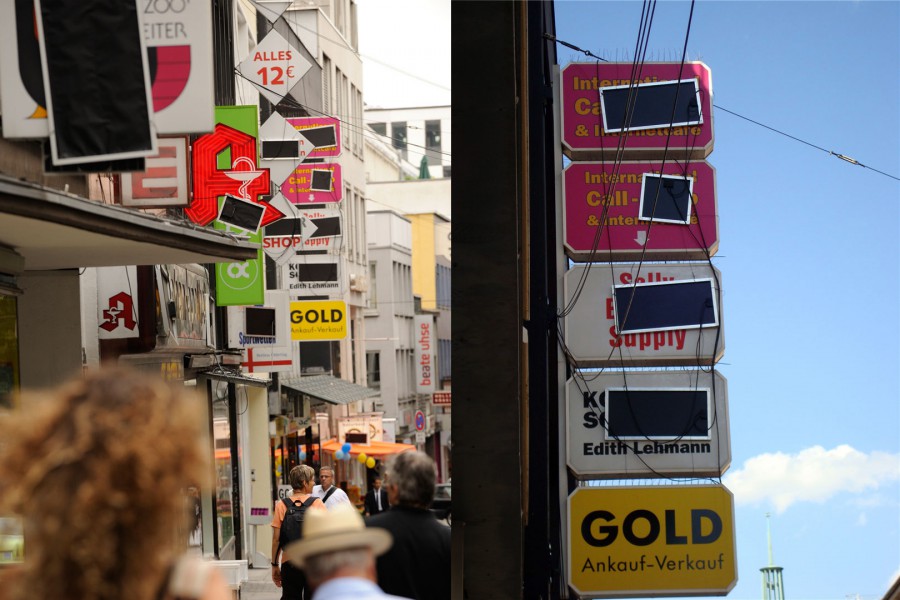
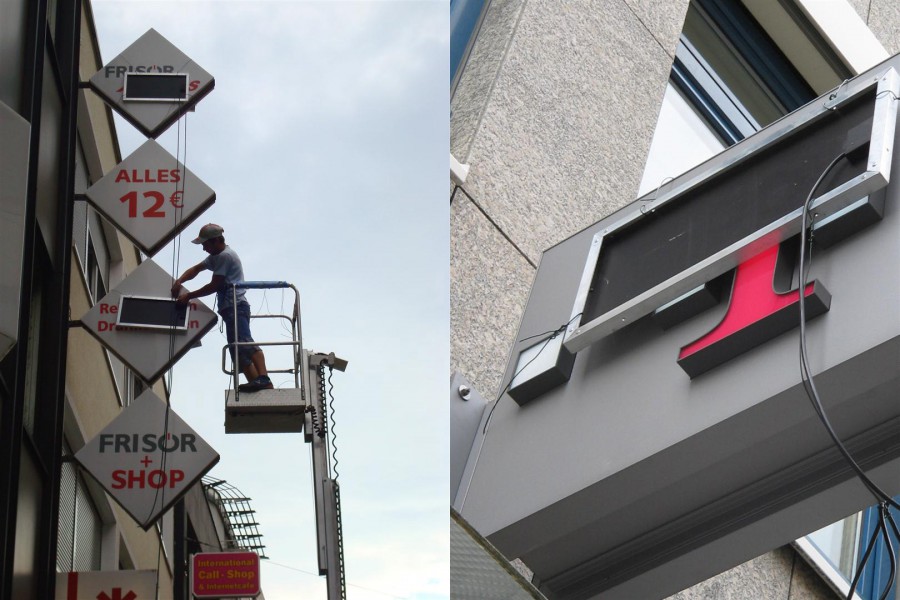
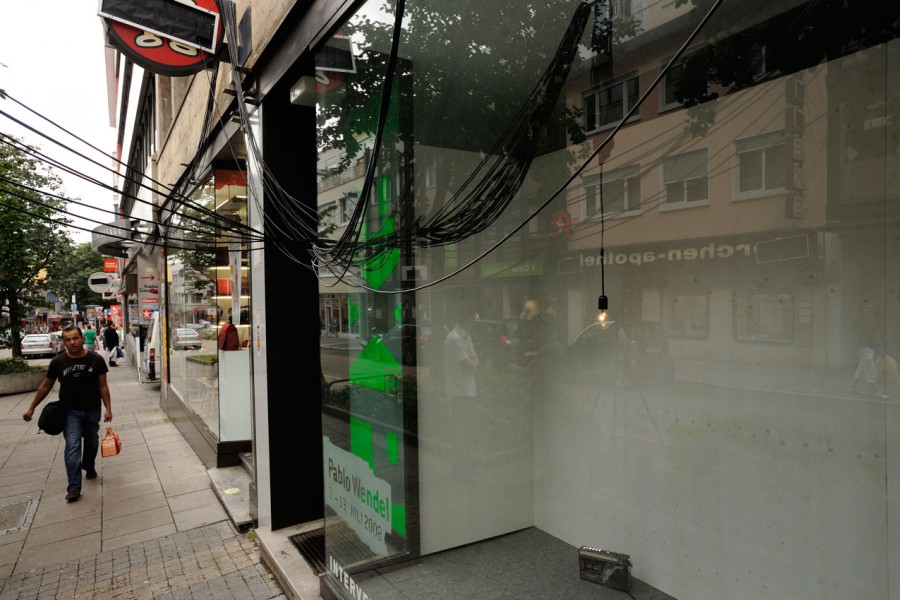
The project Schmarotzer (scrounger) sees the street function as an open exhibition to the public. In this project multiple neon signs in the city centre of Stuttgart were equipped with solar panels. The front of the solar panels were laid on the light source, so that the light generated through the advertisement could be converted into energy. This placement also functioned as an aesthetic censorship of the advertisement – a witty subversion on the normally unavoidable barrage of advertisement the general public is confronted with everyday. A cable from each solar panel was then fed into the window display in the Interventionsraum in Stuttgart, in order to illuminate a single bulb in the exhibition space. Like a parasite, the solar panels took the energy from these advertising boards and used it for it’s own agenda.
Ottomobil
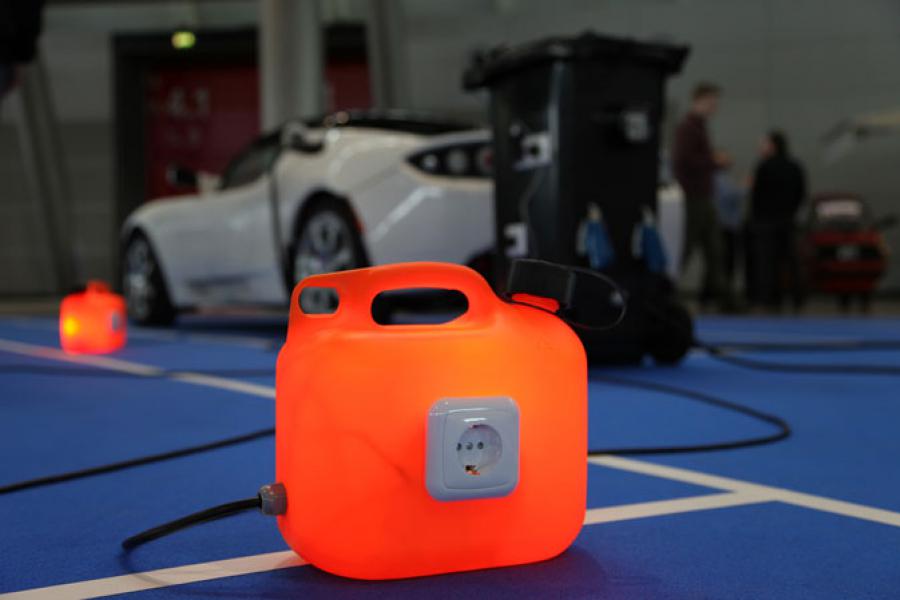
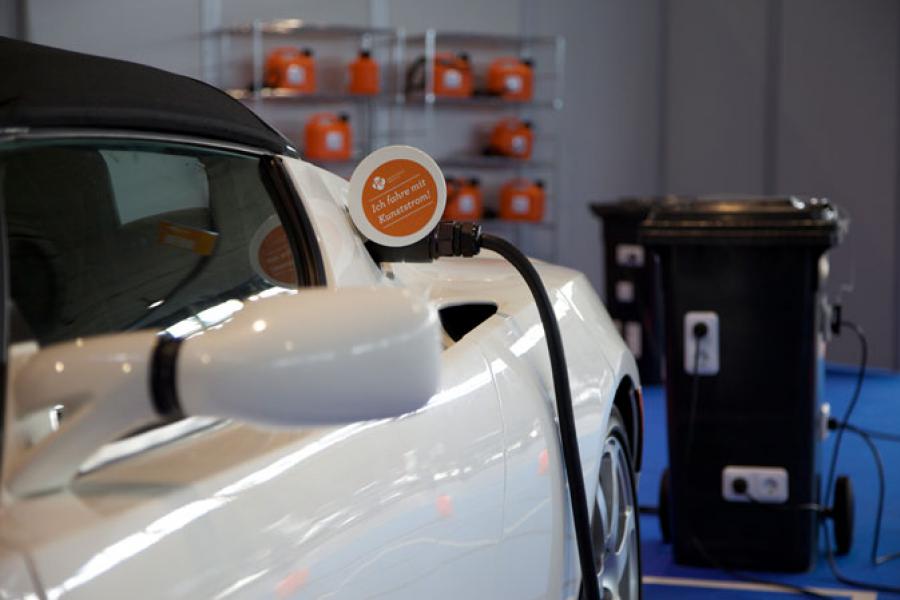
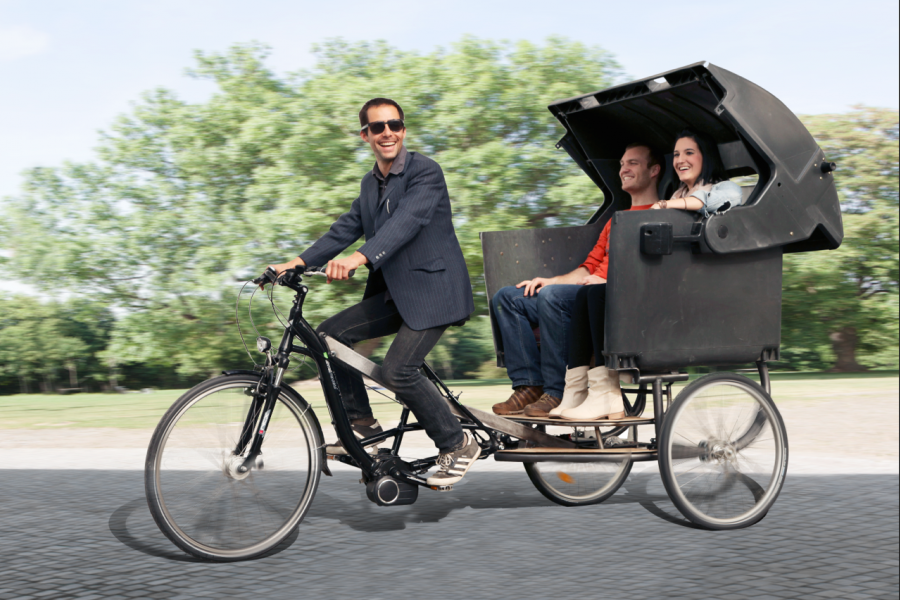
The series Ottomobil was developed by Performance Electrics as a model that simultaneously stores and provides Kunststrom. Fundamentally Ottomobil is a converted trash bin, which is used as mobile storage of Kunststrom that can be placed anywhere according to requirements. The multi-level distribution system is manufactured in different forms and sizes and can function as a charging station for laptops, mobile phones and electric vehicles. As a continuation of the Ottomobil-series Rikscha has been designed with its own independent fleet that is run on Kunststrom.
The development of Rikscha is based on the Performance Electrics mobility concept, which poses questions concerning mobility. Rikscha is made with a dumpster that is transformed into a passengers’ cabin. Besides being an ordinary passenger vehicle, Rikscha is a mobile energy storage that can supply Kunststrom to anyone at any time. Due to the use of recycled materials Rikscha is undeniably sustainable.
Switch supplier now!
Would you like the opportunity to support Art with your utility bill?
Sign up to Performance Electrics and be immediately provided with Kunststrom.
If you would like to learn more about Kunststrom availability or upcoming exhibitions, events and opportunities at Performance Electrics please sign up to the following:
Performance Electrics - Your Connection to Art
Professional Partners
SPECIAL THANKS TO: Gisela Alberich Trullols, Daniel Beerstecher, Nina Bossert, Fabian Brenne, Reiner Brouwer, Marc Bubser, Simona Doletzki, Frederic Ehlers, Konstantin Felker, Birgit Gebhard, Kai Fischer, Arnaud Hoffmann, Birgit Hower, Jana Huber, Dr. Andrea Jahn, Hojin Kang, Alex Kern, Byung Chul Kim, Conny Krieger, Fabian Kühfuss, Jochen Kunze, Maximilian Lehner, Daniel Zaiß León, Vladislav Novicki, Werner Meyer, Christoph Moser, Sebastijan Perkovic, Domile Ragauskaite, Katharina Ritter, Rudolf Reiber, Wendelin Renn, Clemens Rudolf, Christine Rusche, Dafina Sadrija, Aaron Schirrmann, Julika Schlegel, Dmitri Schmidgall, Wasili Seidensal, Darius Sidlauskas, Tobias Sieber, Barbara Stehle, Kestutis Svirnelis, Samuel Treindl, Helen Turner, Christian Wadephul, Wilhelm Wagner, Ramona Wegenast, Martina Wegener, Steffi Westermayer, Rolf Wöhrle, Daniela Wolf, Karl Wruck, Nikolas Clair Boetschi und ZBB.
EDUCATIONAL PARTNERS: Werkrealschule Ostheim Stuttgart, Universität der Künste Berlin, Peutinger Gymnasium Ellwangen, Musikhochschule Trossingen, Kulturagenten für kreative Schule Baden Württemberg Stuttgart, Institut für Photovoltaik der Universität Stuttgart, Institut für Aerodynamik und Gasdynamik Universität Stuttgart, Hochschule Bochum, Gymnasium Plochingen, Goethe Institut Sao Paulo, Friedrich-Schiller-Gymnasium Marbach, Freie Walddorfschule Balingen und Christy-Brown-Schule für Körperbehinderte Villingen-Schwennigen.
Prime Minister of Baden Württemberg Winfried Kretschmann is patron of the project PV Guerilla.
Sponsoren











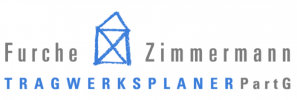




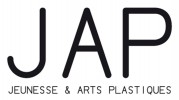


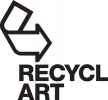



























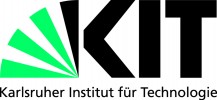

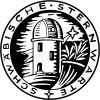
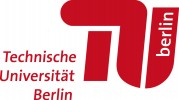
Contact
Performance Electrics gGmbH
Im Schellenkönig 56a
70184 Stuttgart
Germany
T +49711 50 45 43 33
M +49176 21 75 90 64
Pablo Wendel
Herr Clair
Business Development and Creative Director
Pylonia Power-Space Stuttgart
mail@herrclair.de
-
PRODUCTION FACTORY Stuttgart
Wagenhallen, Gate 2
Innerer Nordbahnhof 1
70191 Stuttgart
GERMANY -
OFFICE Stuttgart
Im Schellenkönig 56
70184 Stuttgart
GERMANY -
Kunststrom Kraftwerk Luckenwalde (Power-Plant)
Rudolf-Breitscheid-Str. 73
14943 Luckenwalde
GERMANY
Local Court Stuttgart, Commercial Register HRB 743739
CEO Pablo Wendel